Mili Fay's Blog, page 2
February 15, 2016
Mili Fay's Best Writing Tips: The Idea, Writing, Editing, and Going Public
 MILI FAY'S BEST WRITING TIPS
MILI FAY'S BEST WRITING TIPSThe Idea, Writing, Editing, and Going Public
I love to read articles where famous writers discuss their writing. I always anticipate a grand revelation that will take me from a mere writer to an amazing writer. Such gems are rare and precious. The most precious of 2015 was reading Stephen King declare war on adverbs. The man hates adverbs, and I could not understand why, since I used them often. The key word there is: used. It turns out that adverbs are facilitators for all that “telling” and not “showing”, which you (as a writer) know is the death knell of the written word.
That is all the explanation you will get, because I’m not an editor and this article is not about writing style, but H.O.O.T.’s of Wisdom on writing. If you would like to read a great article that blew my mind on editing, please read Sharon Miller’s Self-Editing Tips: Part 1 and Part 2 .
On Writing
The Idea
 What the inside of Mili Fay's head looks like sometimes. Inspired by Pixar's Inside Out.
What the inside of Mili Fay's head looks like sometimes. Inspired by Pixar's Inside Out.
I find that when I create I get two types of ideas:
1. Ideas that amuse me.2. Ideas that consume me.
The less scary of the two is the first. These are simple ideas that belong to themselves. They come from life; someone would say something, I would see or dream something, read something,… They usually begin with: What if…?
Such an idea resulted in my first artwork book, Animals In My Hair . I heard my mother tell my father that he should get a haircut, because his hair was a forest! (This is a common Serbian expression.) I was doodling in my sketchbook and translated from Serbian into English, then asked myself: What if our hair really was a forest? Surely there would be animals living in the hair. But, why would animals be living in someone’s hair? Because, people have destroyed their habitats and they needed a place to hide! Several years later, I published a book about a little boy who goes for his first haircut and endangered animals tumble out of his hair.
The second kind of idea frightens me, because it is not contained in itself. This kind of idea keeps changing as I grow and change, until sometimes the world I am creating seems more real than the one I live in. It is the kind of idea that can tip a creative mind into madness.
Warriors of Virtue , my fantasy series, grows from such an idea.
Prior to Warriors of Virtue, I was doodling comics with my own and mythological characters inspired by Greek/Roman Mythology and Sailor Moon. One day, I was watching Anne of Green Gables the Sequel. There is a scene where Gilbert tells Anne that she should write about people she knows. I thought that would be fun. So, when I read The Lord of the Rings instead of creating fictional super-characters, I added my cousin, sister, and myself to the story. Eventually, my story outgrew Middle Earth and I created the land of Ardan. Ardan is populated by creatures I have never seen before, and have no idea where they came from. Every character has a life. If I would think about a character, even a minor character, glimpses of their memories would come through. All the pain and sorrow I’ve felt, some characters felt. The fears I’ve had, some characters lived. The meaning of life is revealed in a way that makes logical sense to my own meaning of life. A few years later, the characters that started out as myself, my cousin, and sister, took on lives of their own. Sometimes, I feel as if I’m a conduit to a parallel world, and sometimes I wonder if this world will consume me in the end. Warriors of Virtue is everything that I am and that I wish to become. The stories keep tugging at me. One day, will I forget to tug back?
I fear that greatness or madness is the result of such ideas. I treat them with caution, because only time will tell where I’ll find myself.
Writing
Publishers and teachers recommend writing outlines.
I write outlines… Well, sort of...
When I’m writing a formal paper outlines are essential. They keep me from repeating myself and help me organize the paper in a logical, scientific, manner. I find that writing fiction is different.
Once, while I was still seeking a trade publisher, I tried to write a detailed outline showing my characters’ motivations, conflicts, and resolutions on their journeys. Then I realised that for me, outlines are a waste of time. These days I write a roadmap. I know where my characters are, I know where they’ll end up, but I have no idea how or why they will end up there. I leave that bit of the story fluid, letting the characters take me on their journeys. Often, they surprise me, taking me down paths I would rather not travel… at least not without an invisibility cloak.
Once I have the idea and the roadmap, I write.
At this point I become a filmmaker. All the characters are living their lives. Where do I place my camera? What angle of the story do I show? What do I reveal? How much do I conceal?
There is so much to show, that I have to keep telling myself: LESS IS MORE.
Given half a chance, I would go in and focus on the pale morning sunlight kissing the budding leaves of a powerful oak tree. Unless a character is about to pop up from behind one of those leaves, there really is no point to write about the tree at all—is there?
While writing, I also remember Hitchcock who said he shows the audience only what they need to see.
I write, letting everything pour out of me without stopping, because I know editing comes later.
I also write beginning to end. I may note down bits of scenes to come in a journal, but I never write chapters out of order.
I write and I save often. Then I copy my work in case something happens to my computer.
I also keep an Encyclopaedia of characters, places, magic spells, powers, etc. I’m amazed how faulty my memory of my work becomes… Well, just as faulty as real life memories. However, when writing I need to know that my character wore a blue gown on a particular day, so I would not write about her lovely pink outfit. If my characters go on a journey, I need to draw a map and keep track of their days. If it takes human characters 6 days to reach the Forbidden Mountains on foot, how long will it take the Dragon-Prince Diamond to fly to the Empyreal Castle and back to the Forbidden Mountains?
At one point, I was developing the Ardanian language. However, I decided not to bother, because the language can be gibberish and still add interest to the story.
Editing
Writing is rewriting, and rewriting, and rewriting,…
I wrote Warriors of Virtue when I was sixteen as a 30-page short story for my English class. My teacher nearly had a heart attack; my classmates submitted short stories that did not exceed five pages.
Shortly after, I wrote the second part of the fantasy series (currently titled, Cured by a Rose, a name I will change because it sounds too girly). The second part was about 200-pages long. Then I decided to expand upon the clinical-like precision of Warriors of Virtue.
After sixteen years of rewriting, Warriors of Virtue is about 600 pages in length.
I wrote the original in the past tense. The current novel is in the present tense. There is an excellent reason for this that involves the Three Fates, but I’ve deleted the intro bit that explains why the story can only be written in the present tense, because I wanted the reader to get to the meat of the story sooner in the fantasy series.
I hope I’ve made my point: writing is rewriting.
After I’ve written the first draft, I no longer think of my work as writing, but editing. A great tool that helps me edit my own work is the “Text-to-speech” feature. I’m currently using Microsoft Word, but I’m sure that all writing programs have this feature. Though the computer voice is flat and monotone it helps me pick up on typos and the rhythm of the language.
I would edit my work, then I would turn on the text-to-speech feature and edit the work again. After that I may leave the work for a few weeks, or if time allows months. Then I will edit the work again.
While editing I keep aware of my audience and ask myself: Do I need this to communicate my ideas? Most of the time my work is shorter after I edit, though sometimes it can be longer. People are taught early to connect the dots.
For example: “What do you mean?” He asked bewildered. These two sentences are overkill. The question mark indicates that he is asking (or inquiring, or wondering,...). The sentence itself makes us understand that he is bewildered. Therefore, the sentence in quotation marks can stand on its own.
When writing, I also try to keep my language as simple as possible; I use “talking” instead of “confabulating”. As a writer, I want to make sure that my audience understands what I’m trying to say, instead of impressing them with my handy thesaurus.
Ever since the “congealing dust” incident, I use Google often to define words. I want to make doubly sure I know the meaning of the word I’m using. Google also helps me find adequate synonyms when I find I’ve repeated a word too often.
Another lesson I’ve learned is to avoid descriptive passages. I love descriptive passages. Tolstoy is great when it comes to descriptive passages. However, the reality is that people today have more visual information than people prior television. Think about this for a second. When Burroughs wrote Tarzan of the Apes, he wrote passages and passages describing the jungle. Today, all you need to write is “jungle”, and everyone who has ever seen a jungle travel or nature program knows what a jungle looks like. As an author today, my job is to set the mood of the scene, and that can be done in a couple of sentences. I do not need to go on and on about the crisscrossing vines and broad leaves, sunlight fighting through the foliage,… Unless, the description is important to the character, I leave it out. For example, there is a scene in Warriors of Virtue when the main character stares at herself in a mirror. I could leave most of the character’s description to the reader’s imagination, but in this scene the description is important. The character overheard one of her friends say to the other that she is not pretty enough for a princess, and the character studies herself in the mirror trying to determine if her friend is right.
The sad truth about editing is that it does not matter how many times I go through my work, I always find something I can change to make it better. I must have edited the first three chapters of Warriors of Virtue at least sixteen times in sixteen years. My editor went through the work, and at my last attempt I found bits and pieces to delete. An important part about editing is learning to let your work go, because if you do not stop, you will never publish.
Yes, your writing will improve with time, and you will cringe at the work you have done only a few years ago, but that is all part of a writer’s life. I know I have to accept that what I have done is the best that I can do at this moment in my career. Then I need to trust my editor to see the mistakes I’ve missed. After, the public will let me know if my book is worthy or not.
Going Public
Never let others know you have doubts about the quality of your work. If you let the public know that you do not feel good about what you have done (which I think every author on the planet does) the public will choose another book to pass their time. Never, ever, defend your work (unless you are fighting for your PhD). As an author I have something to say, and if I’ve managed to communicate that something to my readers that is all that matters.
I have days when I think my work is the greatest written piece since Shakespeare, and days when I think I should forget about writing and just focus on being an artist. This is normal.
So far, everyone has loved Animals In My Hair. I do not have a single negative review. This does not mean that I will not get one someday. Negative reviews are perfectly normal. The ones that explain why they do not like the book help improve the work. The ones that are negative just for the sake of being negative are written by Trolls and should be ignored. Creative works by nature are subjective; a question of taste formed by experience, rather than conclusion backed up by evidence. A lot of people loved Napoleon Dynamite. I cannot recall why, but I remember after watching the movie that I wanted those two hours of my life back. This does not mean that the movie is bad. It just means that the movie is not for me. Game of Thrones is insanely popular, but I doubt I will ever read the books or watch the series even though I am a fantasy fan. Why? Because I do not like excessive blood, death, and gore. By reputation, Game of Thrones is riddled with all three. The key when writing is to find a group of people who will love what you do (your audience) and make them happy. I have a small group of such fans, and I’m grateful to them; not only for their support, but because their praise inspires me to be better and gives me courage to take risks.
When you go public, everything you ever write online is online FOREVER. Keep in mind you ARE under public scrutiny, even if you are not famous and no one is reading your blog at this time. Once you find your audience and your work takes off, your fans will look you up online. The moment you become a great success, there will be those who will wish to pull you down. It’s human nature. I never understood why people love to trash and invade celebrities’ lives, but if you went on a rant in your teen years, that rant will find its way to a magazine once you step into the light. We all have our moments, I know I have mine, but there is no reason to “air out your dirty laundry” in public.
Now that Warriors of Virtue is only a few months away from publication, I find I cannot settle. I wrote this series, because I wanted to read this series. Reading Warriors of Virtue the last time, I loved the story. I wrote it and still I found myself shivering and laughing at bits. That must mean it’s good, right? I wrote this story for me, but now I want to share it with the world. Will the public like it? Will they think it the greatest thing since Harry Potter, Sailor Moon, The Lord of the Rings, Avatar the Last Airbender? Only time will tell. I have had my say, the public will have theirs. I believe that most people will enjoy this work, but what I know is that I’ve given everything I have to this story. As an author, at the end of the day, that has to be enough.
H.O.O.T.S of Wisdom
Hire a professional editor. Do not publish unless a professional editor (or at least a PhD in English graduate) with credentials edits your book. It will not matter if you've written the greatest story ever, if you've done so with poor style, faulty grammar, and lots of spelling mistakes. An editor is not where you want to skimp if you are self-publishing. There were books whose ideas I loved, but I could not get through because English was terrible. One of these days, I'll contact the author and beg him/her to hire a professional editor, republish the book, and let me know when the new version is out because I really want to read the story.
Keep a notebook by your bed, and one near you at all times. You never know when a great idea will strike. I cannot count on my memory to remember everything. Can you?
Write out character sketches for every character in your book. Copy and Paste text where they are mentioned with page references. Create your own Encyclopaedia. You can use this in the future to promote your novel.
Think of yourself as a filmmaker not script writer. Instead of telling what your characters are doing, show us how they look, the movements of their hands, reactions to scenes, etc. Every gesture must have a meaning to the story. If a gesture does not reveal something about the character or the story, leave it out.
When you are ready to go public, create a platform for yourself, have a website with your own domain, and a blog where you can connect with your fans. Even if you are not yet famous, think of yourself as a public figure and act with wisdom and grace. Ask yourself: do you want to be a fad or an institution?
-----------------------------------------

Mili Fay, a Toronto-based artist, classical animator, illustrator, writer, and singer, is an award winning graduate of Sheridan College and Art Instruction Schools. In November of 2011 she created Mili Fay Art determined to support the world one artwork at a time.
Currently, Mili is working on her first ever illustrated Fantasy series, Warriors of Virtue , about a reluctant princess who must prevent a war with the dragon-people, while keeping her mission a secret from her over-protective mother.
Her latest published work is Animals In My Hair ; a story about a boy who goes for his first haircut only to find endangered animals falling out of his hair.
Join Mili Fay Art Fan Club to stay in touch with Mili Fay and to be the first to find out of her upcoming books and artworks.
Mili Fay Art: “Together we support the world one artwork at a time.”
Published on February 15, 2016 03:46
November 1, 2015
Defeating Artistic Blues: Mili's Tips On Finding Happiness During Blue Days

DEFEATING ARTISTIC BLUES
Mili's Tips On Finding Happiness During Blue Days
Warning: This article talks about my sad days and my thoughts on suicide. There will be a lot of personal honesty that may make you feel uncomfortable. If you are looking for something fun to read stay away from this article.
Bundled up in my warm coat I’m happily walking down the street, enjoying the crisp fresh air of approaching winter, when I suddenly hear: “So this is Christmas, and what have you done?”
I really, really, REALLY despise this John Lennon’s song, and especially that lyric. It does not matter what I have done, I always somehow feel I could have done more. So, I wrote a book, painted some really great paintings, won an award, travelled… But maybe if I was more clever and less lazy I could have brought about world peace or cured cancer?
Suddenly, I am nothing. I am worthless.
If this does not sound familiar, thank your lucky stars, because I believe this is what everyone refers to as “artistic temperament”. I call it: “disproportional sensitivity to stimuli, resulting in crazy pendulum swings of emotions”. However, “artistic temperament” will do.
I am not alone. I use to think I was, but after living with creative people, I have found these reactions rather common among my species. It may be a cliché, but we artists are a sensitive lot.
I believe that if I was kept in a bright vacuum, I would spend my life feeling positive and content. I am at the core a happy person. In company, I’m mostly happy and sometimes bubbly. A friend once said I reminded him of a Disney Princess--singing included. However, this happiness is sometimes a mask I wear in front of people I do not know well. I was raised to be pleasant in company and solicitous of other’s feelings before my own. Therefore, regardless of how I’m feeling, I will never show a negative side to a stranger. I will even keep any negative feelings from my close family and friends, because I do not wish to burden them. Rarely, will I let the sadness I feel emerge to the surface for others to see.
I do not remember this, but recently I met with an old school friend who has a memory of playing with my sister, because I had one of my crying fits. When she asked my sister what was wrong, she replied: “Oh, sometimes she just has to cry.”
I am older now, but I still have days when I just have to cry. I am content most of the time, but there are days when I feel despair; such deep despair that I wonder if life is worth living. I usually have these days when I have not seen the sun for days, when I’m sick, or when a project is not going as planned. Sometimes, during these crying fits I do not even know why I’m sad. The rational part of me argues that my life is good. I may have personal difficulties, but who doesn’t? I may not be a famous artist making the big bucks, but I have a home and people that love me. I have seen and done things most people dream of, so why am I so sad?
On the other hand, the emotional part of me sees life as a deep dark hole full of pain and series of disappointments and losses, and wonders why I should suffer through it at all. Wouldn’t it be nice if I was just gone? If there would no longer be this terrible pain? What do I contribute to society? Am I not just a burden to people who love me? One slice to the brachial artery and it can all end in minutes…
Online other artists seem always successful and happy, sometimes angry, but none are sad or talking about how difficult a life of an artist can be. I wondered if there is something wrong with me. Am I the only artist struggling to make a living? Then I realised, I too only wrote about my successes and shared my triumphs with my fans. I never wrote about how being sick for months made me want to end my life; how there are days when I feel I can save the world and days when I can barely get out of bed; how sometimes I cannot draw, because I hurt too much; how I worked for below minimum wage and was not able to scrape a living; how I could not understand why I’m failing in real life when I was so good at school…
Is it possible to feel too much? I believe that it is this artistic sensitivity that makes me a better than average artist and writer. My skills might not have reached the level of unsurpassed mastery, I am not Shakespeare or Monet, but I have deep empathy and a well of feelings that lets me put emotion into my work that strangers can experience. I also believe that this sensitivity to life around me that makes me special is my greatest weakness. The pendulum swings of my emotions that hits the highs and lowest lows sometimes frightens me.
I had to find a way to bring my feelings under control. Should I look to my fellow artists for a solution?
I like my ears well enough, thank you Van Gogh.
I also have no intention of ever using drugs or alcohol to make myself feel better, thank you other famous artists.
Manizing? (Is there a male equivalent to “womanizing”?)
No, thank you.
Eventually, I did discover what works for me, and I hope these H.O.O.T.s of Wisdom on dealing with Artistic Blues will help you as well.

H.O.O.T.s of Widsom
Defeating Artistic Blues
Avoid negativity. Negativity can come in many forms. The worst comes from the people you care about, because their opinions matter to you. However, negativity can come from outside sources as well as fiction.
When Artistic Blues hit I avoid all negative sources of energy. I try to keep away from negative bitter people. I stop watching the news (Can they never report the good things that are happening in our world? What can I realistically do about any disaster?). I keep away from drama and horror, and opt to watch or read comedy instead.
Smile. I believe that life trains us to deal with disasters. We remember disastrous experiences better than the good ones, because we need to protect ourselves in the future. However, we must not forget that Life is beautiful! Why worry about disasters that may never happen? Find something to smile about today.
If you cannot think of anything under the influence of the Artistic Blues, get up, stand in the superhero position (your hands on your hips, feet apart, head high) and smile. Stand like that until you do remember something good and happy in your life you can truly smile about.
Forgive yourself. Currently I’m taking an online course with a great artist who has an enormous lack of sensitivity to others’ feelings and temperaments. He has health, energy, and will to create dozens of sketches a day and fill out a sketchbook every month. In his lectures he goes on to browbeat us students with sentences such as: “If I could do this assignment daily in my great busy life full of responsibilities you wish you had, then there is no excuse why you cannot do the same.”
I would leave his lesson determined to prove to him that: “Yes. I am great. I can do just as much as he can.” Then… Life happens and here I am: my homework is not done and I feel a complete and utter failure. I have spent days feeling like an utter failure, not just as an artist, but as a human being. The Artistic Blues have hit me again, resulting in me doing even less, because I cannot produce quality work when my feelings are a mess.
Then one day, I decided to forgive myself. I am not the same person this great artist is, but that does not make me any less an accomplished artist. The important lesson I’ve learned is to accept that everyone is different.
Please do not feel you are a failure if you cannot fill out a sketchbook every month, or if you cannot publish a book every two months. Jane Austen only published 6 books in her entire lifetime! Harper Lee wrote two! So, you may not be Nora Roberts, but that does not make your artistic contributions any less valuable.
Forgive yourself. You are human. Someday you may write/draw more, someday you may not write/draw at all. Therefore, forgive yourself and let the ridiculous expectations of others go.
Look at what you’ve accomplished! In addition to forgiving myself for not being superhuman, I stopped comparing myself to others. For years I felt a complete failure when I compared my work to my heroes. What I did not realise is that I was comparing myself to artists at the height of their careers. Then one day I went to an art fair where I saw what people my age were creating, and I was fine. Of course I’m going to be a better artist ten years from now than I am today. In ten years I will gain more experience and will gain more knowledge.
What about artists who are younger than me and are producing better work?
Well, good for them. They do not have the experiences in life that I had. Maybe they come from artistic families who guided them and they did not have to stumble as much as I did? Maybe they are prodigies? Who cares?! What’s important is what I can do.
Just keep working on your skills, create, measure your own accomplishments, and stop obsessively comparing yourself to others. Look at what you’ve accomplished!
Keep a Happy Book. When Artistic Blues hit and I am moping around my home feeling worthless, a waste of space, and that the world would be a better place without me in it, I go and read my Happy Book. For my birthday my friend gave me a journal and told me to fill it with only happy experiences. I named it Happy Book and in it I record the nice things people say about my work, myself, and any achievements that make me proud. When Artistic Blues hit, I cannot remember these good things about myself. I only see my failures and the bad things that surround me. By rereading some of the happy experiences, I realise that life is not as horrible as I think it is, and that I’m not as worthless as I think I am.
Accomplish something every day. The night before, or while I’m brushing my teeth in the morning, I think about what I wish to accomplish that day. I start small. I’ve learned not to put too much on my plate. At the end of the day I check off the items from my list. I transfer the items I failed to accomplish that day onto another day, but instead of berating myself for the things I have not accomplished, I gratefully admire everything I have accomplished today.
If you find you fail to accomplish all your tasks, do not despair; this usually means that you’ve given yourself too much work. In the future adjust your schedule accordingly.
Never forget: Adding a grain of sand day by day, will eventually make a beach.
When Artistic Blues hit you the hardest and you feel you cannot work at all, accomplish just a small task. I find usually that accomplishing something small will give me momentum to keep working. Whether it is just a single rough sketch of a would-be illustration, or a couple of pages of text--what you have accomplished that day, you will not have to do tomorrow.
Do what makes you happy. Sometimes when I feel the pressure of a complicated assignment, or if I’ve been working too long on a project and have been drawing in the same style for months, I have to step away from my work and do something that makes me happy. I like to do Mini-MEs, or draw princesses. I’ve always drawn princesses. Drawing princesses makes me happy, because it takes me back to my childhood when I was happy. I allow myself to get silly and fanciful, before I have to get back to the real work.
Go outside. Staying indoors too long can make anyone blue. I sadly tend to spend way too much time indoors. I blame the Toronto weather. Even if I do not go anywhere, in Summer I can sit outside, work, and not feel dreadful. In fall, winter, and early spring I would look outside my window and all I want to do is burry myself in blankets and go back to sleep until the sun shines again. Instead, I force myself to get dressed in my heavy winter clothing and go outside for a six-kilometre walk almost every day. Fresh air, even if there is no sunshine, can do wonders to revive my spirits. It’s even better if I can find someone to keep me company. But if not, a romance novel or a fun fantasy audiobook is almost as good.
Exercise. Though exercise might be the last thing on your mind when you are Blue, getting your heartbeat up and allowing the endorphins to kick in will perk you up. The knowledge that you have done something good for your health will make you feel better, too.
Avoid sweets, alcohol, caffeine,… When I’m Blue, my weapon of choice is chocolate. Yes, chocolate does make me feel better, but then after a few minutes I feel even worse, because not only am I sad, now I feel I’m getting fat! The temporary high of an influential substance is not worth the deeper misery that will follow. Exercise is a much better option. If I really need something sweet, fruits should do. If not, I try to limit myself to one or two squares of dark chocolate, and not a whole bar.
I hope you find these H.O.O.T.s of Wisdom useful. If none of these tips help to dispel the Artistic Blues, you may need to seek professional help. I know a few friends who are on anti-depressants and their lives have improved immeasurably. There is no shame in asking for help.
Do you have your own tips for avoiding Artistic Blues? If so please share them.
Until next time,
Mili
-------------------------
A few thoughts on suicide:
Have I ever thought about suicide? I’m an artist, the moment I hear something I think about it, imagine it, and live it. (Another reason why I stay away from horror movies, or anything depressing.) I have mostly thought about suicide after reading “Veronica Decides to Die” (Paulo Coelho) and “Pilgrim” (Timothy Findley).
Have I ever planned my suicide? Yes. Frequently. The last time was at the beginning of this year when I was sick for months, having one cold or flu after another. I could do nothing but stare at TV all day, or listen to audiobooks. There were things I needed to accomplish and I could not accomplish one. Even after I got better, I could barely walk around the block. I remember thinking my winter clothing was too heavy.
How would I end my life? Cutting the brachial artery with my x-acto knife.
Would I ever commit suicide? Not as long as there is a single person left in this world that loves me. My friend’s younger brother committed suicide when I was in college. He was a teenager at the time. I kept imagining how I would have felt if my sister did the same. Regardless of the pain he felt, there were people around him that loved him and would have been willing to help him if he just asked. Suicide is a selfish act. Ending my life like Cleopatra at the end of everything, so I would no longer suffer is acceptable to my sensibilities. However, causing pain to people that love me is not.
-----------------------------------------

Mili Fay, a Toronto-based artist, classical animator, illustrator, writer, and singer, is an award winning graduate of Sheridan College and Art Instruction Schools. In November of 2011 she created Mili Fay Art determined to support the world one artwork at a time.
Her latest published work is Animals In My Hair ; a story about a boy who goes for his first haircut only to find endangered animals falling out of his hair.
Currently, Mili is working on her first ever illustrated Fantasy novel, Warriors of Virtue , about a reluctant princess who must prevent a war with the dragon-people, while keeping her mission a secret from her over-protective mother.
Join Mili Fay Art Fan Club to stay in touch with Mili Fay and to be the first to find out of her upcoming books and artworks.
Mili Fay Art: “Together we support the world one artwork at a time.”
Published on November 01, 2015 06:49
July 30, 2015
Illustration Research Package: How To Prepare An Illustration Research Package To Minimise Your Project’s Cost?

ILLUSTRATION RESEARCH PACKAGE
How To Prepare An Illustration Research Package To Minimise Your Project's Cost?
In the previous articles I attempted to solve the mystery of illustration pricing and to guide you to your perfect illustrator. I have mentioned that one way to minimise your cost when hiring an illustrator is to prepare the necessary research for the illustration project.
In my experience and my friends’ experience I find that regardless of our skill level all of us turn to Google before beginning any project. Let’s say your project is set in 18th century France. Most people when they think of France would think of Paris with the iconic Eiffel Tower. However, Eiffel Tower did not exist until 1889! What did the Paris of the 18th century look like? What clothing did people wear? Did men and women mingle as we do today? What was the difference between the upper classes and the lower classes—is it just in clothing, or is there a way a servant would stand compared to the master?...
If you have plenty of money and are willing to pay an illustrator to spend a lot of time on research, please feel free to do so. However, if you are pressed for time and cash it is up to you to give your illustrator all the information he/she may need to begin illustrating the project. No one knows your project better than you, so before contacting an illustrator think about how many illustrations your project needs and what kind of visual and written information the illustrator may require. Then do the research and create an Illustration Research Package.
Illustration Research Package
Currently one of my projects is a fantasy novel called Warriors of Virtue. You would think that as the author I know what my own characters and settings look like. Let me see if I could explain why I do not.
The main character lives at Empyreal Castle, crafted by the most skilled dwarfs when her family came to power at the end of the Great War. Resting atop the Empyreal Hill, the castle is a tall red-roofed and white-walled structure. It has four main doors on each of its compass sides: gold to the North, silver to the South, copper to the West, and oak to the East.
Close your eyes and picture this castle.
Do your castle’s walls make a square? Does it have a tower on each corner, each one of different height? Are there window corridors connecting the towers and the walls to the central circular throne room with a glass covered dome? Does the castle have outdoor terraces at the Queen’s and King’s living quarters? Are there walled gardens, kitchen gardens,… What about the stables and the grounds? Can a giant fit comfortably in the rooms?
I think you get my point; there is much more that I see in my head than I have written on the page. There is even more that I do not see, but I know that it should be there. Ardan, the land of the Empyreal Castle, is a fantasy kingdom. There it would not be unusual to encounter giants, dragons, sphinxes, mermaids… I know of these things, but I know little about them; therefore, I have to research. How can all these different peoples live in harmony in a single castle?
Settings are complicated, so for the purpose of this article, let’s see how you would create an Illustration Research Package for a single character.
Designing Vert Swiftwing: Illustration Research Package Case Study
Character Description
Vert (vɛʁt) Swiftwing
Lives at Forbidden Mountain Prince Diamond’s Captain of the Guard and best friend 200 years old, but he looks 20 Race: dragon-people Race Characteristics: extremely handsome/beautiful, look human, but can turn into dragons at will, straight hair, can have any natural skin colour, intensely coloured eyes Vert can turn into a green dragon at will Height: 6’ 4” Skin: Caucasian mix, flawless, permanent perfect tan Body type: dancer Hair: dark brown (looks black), slight wave (unusual in dragon-people who have straight hair) Eyes: very green, ranging from light green to the colour of wet leaves Characteristic feature: big smile that often turns into a grin or an amused smirk Character traits: friendly, great sense of humour, brave, kind, loyal, generous Character flaw: impulsive, over confident Dragon: Green, long body, moves swiftly and as silently as a wind, blends with the tree canopy Parents: Classified Sexuality: Bisexual Clothing Reference: Dragon-people do not feel cold or heat as humans do; therefore their clothing tends to be of lighter materials. The cut is similar to what one would see in Medieval Western Europe; tights, puffy-sleeve shirts, tunics with embroidered coat of arms, leather boots, swords, cloaks… As the Captain of the Guard, Vert sometimes wears a light silver-plated vest that can protect his chest from most cuts and thrusts. Costume colour combination: shades of green and brown, with gold embroidered accents
Photographic Reference
I usually find everything I need by Googling images with descriptive keywords. Two other great sources of images are Pinterest and DeviantArt. If these fail I go to the reference library and museums. Sometimes, I have to purchase books, too.
Even though I have an idea in my head of what the character should look like, until I find the appropriate reference it is just a vague, blurry image in my head. As I am doing this part of the research, I feel like a Casting Director asking myself: “Who would be the best person to play the part?”
Most of the time, I find a combination of images and blend all the people into my one perfect character. That is the beauty of art, we artists do not have to depend on an actual person to play the part.
Sometimes, as I did while searching for Vert, I would come across a photograph of a person that fits the character perfectly. That vague veiled image in my mind suddenly clarified as I looked at the following photograph and I said: “Oh my God that’s Vert!”
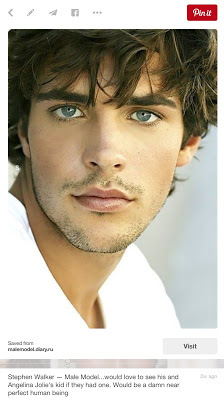
 Source Link
Source LinkFrom his shaggy hair to the structure of his face the model Stephen Walker is the perfect man to play Vert. The only feature that does not fit are his eyes, but I found them on another man:
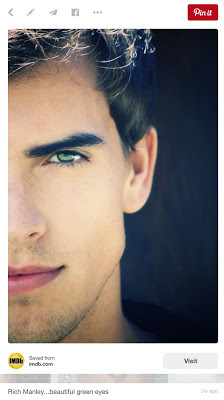
These are basic model photographs. As an illustrator I need to know how this character would move. Vert is someone who would fearlessly leap off a balcony and transform into a dragon. He is not human. Elements that influence his life are air, fire, and earth.
The closest humans could come to Vert’s moves are male dancers. Therefore, I tried to find some pictures of male dancers to inspire Vert’s movement.
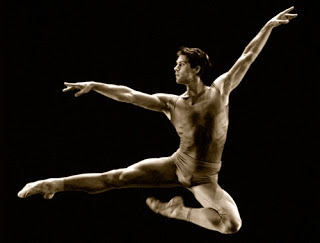 Source Link
Source Link Source Link
Source Link Source Link
Source Link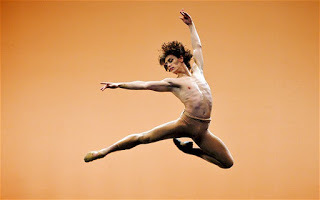 Source Link
Source Link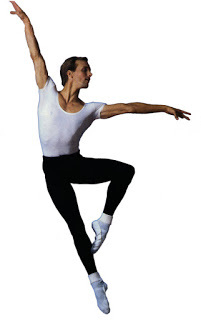 Source Link
Source Link Source Link
Source Link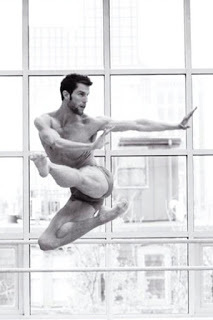 Source Link
Source Link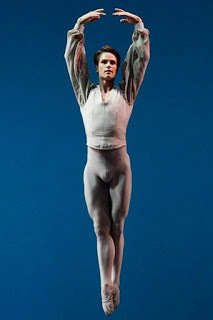 Source Link
Source Link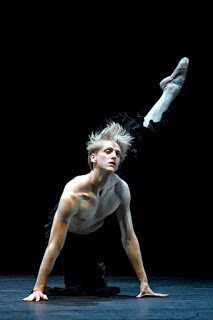 Source Link
Source LinkAnd here are some that should inspire his dragon’s shape.
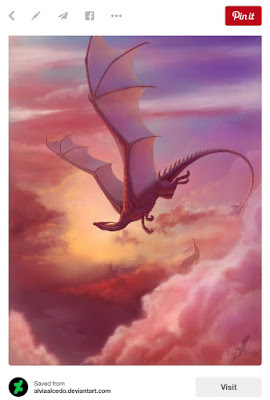 Body shape fits Vert as a dragon.
Body shape fits Vert as a dragon.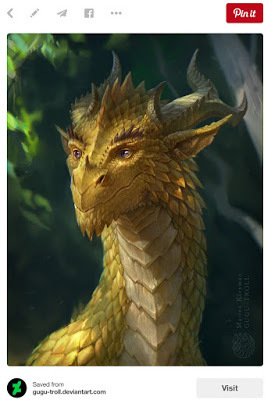 I like the humanity in this dragon's eyes.
I like the humanity in this dragon's eyes.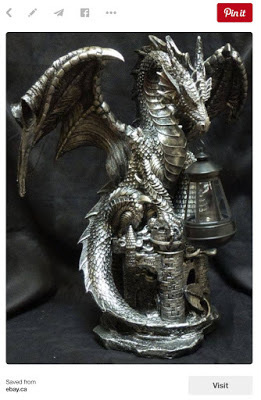
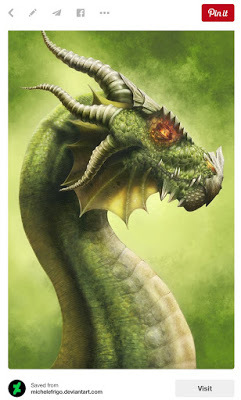
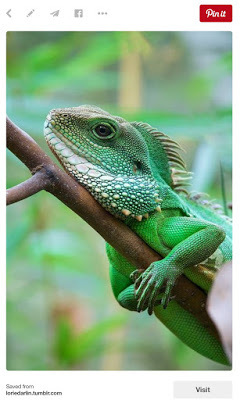
Now that we know what Vert would look like and how he would move, it’s time to clothe him. Since this is a fantasy novel, costumes do not have to fit reality. I can mix cultures and time-frames and it will still be acceptable as long as there is a reason for me to do so. When I think of the dragon-people they are dressed in costumes resembling those of Middle Ages. So, I Googled “men’s costumes Middle Ages” and discovered a costume shop, “ Dark Knight Armory ”.
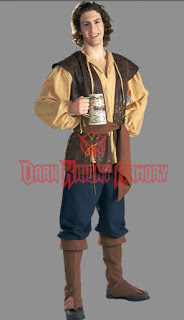 I like the shirt, and maybe the vest in this photo.
I like the shirt, and maybe the vest in this photo.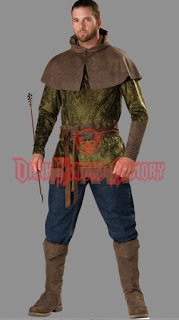
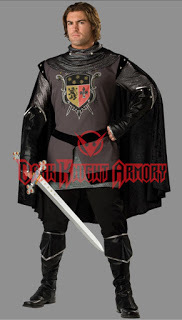
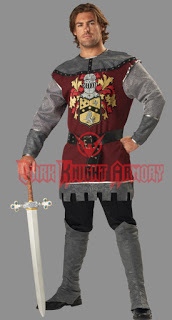 I like the material of the sleeves. It almost looks like dragon scales.
I like the material of the sleeves. It almost looks like dragon scales.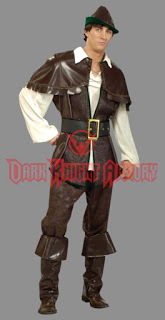
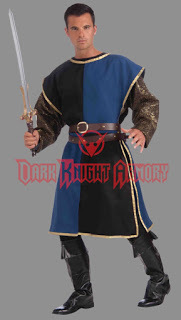
Clearly these costumes are not of the quality or materials one would expect in reality, but they give me the shapes and designs to work with. When it comes to costumes and props, not only do I need to know how something looks like, but why it looks as it does. For example, if Vert was to carry a sword, what kind of sword would it be?
In the Royal Ontario Museum there is a room of various armour pieces and each piece had a function. The variety of swords had me taking notes and sketching for hours. There were single hand swords with a short hilt. Double hand sword with a long hilt. The groove down the middle of the sword was not just for decoration, it was to direct blood away from the edges. The swords for cutting are broader, the ones for stabbing have a sharper point. The really long swords that look as if no human should be able to lift them and spears were used to hold the front line and to prevent horses from getting through…
Vert moves swiftly. His costume and props should reflect that aspect of his character. Therefore, for everyday protection, I do not think that he would carry a heavy two-handed sword. He would most likely not even carry a sword on casual strolls, since he can turn himself into a dragon; maybe he would only wear a dagger? However, as a 200 year old man and as the Captain of the Guard he is able to wield any weapon known to man and is not afraid to take up the best to suit his needs.
I may have to do more research depending on which scenes with Vert I’ll need to illustrate, but the character description and reference photos provided here are enough for me to start sketching. What you see above is the minimum of information you will need to provide to your illustrator for every single character.
Settings are even more complicated. If your illustrator needs to draw them, even if you want to leave your readers with only the description saying “opulent room”, the illustrator will need to know the details: How many doors into the room? Is there a hidden entrance? A terrace or balcony? Is the room panelled or does the stone show through? Wall decorations? Furniture? Where are the windows facing? A light from a North window is different from that of a West window, especially at sunset. You need to provide visual reference and written information for everything!
HOOTs of Wisdom
Illustration Reference Package For Authors
Research.While you are researching for your project, keep in mind that your illustrator will not only need to know how something looks like, but also how it moves and why it exists. As you are writing your own notes, keep a separate file of relevant information that you will share with your illustrator.
List. Less is more. Time is money. There is no need for you to include pages and pages of writing. Point form list is more than enough.
Variety.Include a variety of images from different angles when possible. The best photos for drawing people are the ones when the subjects are seen in a ¾ view. If you can, also include the subject’s profile, front, and back.
Organise. Create a main folder for your project, then create sub folders for settings, characters, and props. Within those folders create a separate folder for every individual subject matter. You want to include a copy of the prop a character is using within the character’s folder as well as in the general prop folder. If your characters are related, make sure to include a note of their relatives in every description, because these characters will have to look alike.
As always, if you have more questions, please write them in the comments and do not hesitate to contact me on social media.
Cheers!
Mili
-----------------------------------------

Mili Fay, a Toronto-based artist, classical animator, illustrator, writer, and singer, is an award winning graduate of Sheridan College and Art Instruction Schools. In November of 2011 she created Mili Fay Art determined to support the world one artwork at a time.
Her latest published work is Animals In My Hair ; a story about a boy who goes for his first haircut only to find endangered animals falling out of his hair.
Currently, Mili is working on her first ever illustrated Fantasy novel, Warriors of Virtue , about a reluctant princess who must prevent a war with the dragon-people, while keeping her mission a secret from her over-protective mother.
Join Mili Fay Art Fan Club to stay in touch with Mili Fay and to be the first to find out of her upcoming books and artworks.
Mili Fay Art: “Together we support the world one artwork at a time.”
Published on July 30, 2015 19:22
May 4, 2015
Hiring An Illustrator: Where To Find The Best Illustrators For My Project?

HIRING AN ILLUSTRATOR
Where To Find The Best Illustrators For My Project?
In my last article I’ve discussed the cost and process of illustration. I have also shared with you what you can do to make your illustrator’s job easier and keep to your budget. If you have not read the article, you may find it here .
Now, that you know a bit about the business of illustration, you may feel ready to hire an illustrator, but where to begin?
There are millions of illustrators all around the world; how do you find and choose the one that’s perfect for your project?
I am fortunate enough to be an animator, artist, illustrator, and writer. I have published Animals In My Hair all by myself. Last year at international and local fairs, I have proven that Animals In My Hair can stand with, or even surpass trade publications. Being this fortunate, I sometimes take my knowledge of art for granted and I forget that there are brilliant writers out there who cannot draw a stick figure.
As a trained artist, I can look at art and judge it for its quality in seconds; but, I ask myself, how can someone who has no training recognize quality artwork? Art is so subjective. It truly depends on individual taste. There are illustrations some people adore, yet I simply don't care for them. Does that mean that those illustrations have no merit? Absolutely not. My taste is my taste and your taste is your taste.
The trouble with finding an artist to illustrate your work is that you are not catering to your taste, but to the taste of your audience.
Therefore, before considering hiring an illustrator you should ask yourself: who will buy my book and what do I want to accomplish with my book*?
Illustrations from adult non-fiction books usually vary greatly from those found in children's picture books. Will your book be a guide to professionals, or something readers will use to escape reality?
If you have written a number of children’s short stories that you want to publish as individual picture books as quickly as possible, a simple illustration style of Ruth Ohi may be preferable to the detailed style of Graeme Base . Remember: the more detail an illustration has, the longer it will take to create. Ask yourself: do I really need those “Disney-style, full colour” illustrations?
Before looking for your illustrator, I recommend—scratch that—I INSIST that you visit your local book store. If there are no book stores in your area, you can also visit a library, or Amazon.com.**
At the book store, while looking at a wall of books in your genre, choose one. The moment you pick it up, ask yourself: why did I choose this book?
The book you picked has caught your eye out of dozens. What makes it special? Is it the subject matter? The artwork? Colour?
To the designer who created that book cover, you are his/her perfect audience. That book cover has done its job and done it well.
Look at other books. Which stand out and which do not? Look at their illustrations. Why do you like them more than other illustrations?
Take note of the staff picks and best sellers, maybe even ask staff members which books they like and why.
Repeat this process through several book stores until you see an emerging pattern: what makes these books great when it comes to illustration?
Armed with this newfound knowledge, the next thing you need to consider is your budget. In my experience authors often feel that illustrators are expensive. If you read my previous article , and have a sense of the work involved, you will know what constitutes a fair price for your project.
NOTE: NEVER ask illustrators to send you a few test drawings of your characters for free. If you cannot afford sketches evaluate them based on their portfolio.
Remember: the more detailed an image, the more time it takes to create, the more expensive it will be.
Now, you are ready to find your illustrator.
What makes an illustrator great?
Skill. Your illustrator can be professionally trained or not, but he/she must be able to draw what you need.
If your project calls for a lot of diverse human characters, as you are looking through portfolios pay particular attention to faces, hands, and feet. Are the characters conveying emotion? Are they diverse? Do they have different body types, or are they all the same? Can you easily tell what’s going on in the image, or are you confused? Do the characters look like they are in motion and alive, or are they stiff? Look for illustrators who have a sense of layout, because you may be able to avoid hiring a designer to arrange illustrations and text.
 This is an older drawing of mine when my drawing skills were not as good as they are today.
This is an older drawing of mine when my drawing skills were not as good as they are today.
 I drew this in 2014. You can see how my skills have improved when drawing a human figure.Style. Look for the style (i.e., the way something looks) you believe should be used for your book.
I drew this in 2014. You can see how my skills have improved when drawing a human figure.Style. Look for the style (i.e., the way something looks) you believe should be used for your book. Most illustrators have a certain look to their work, a signature way of drawing. If you feel that their look is something you want replicated, get in touch with them. You may get lucky and have the artist start working for you right away, but be prepared to be placed onto a waiting list. There are also a few illustrators (I fall into this category) that work in multiple styles. In forums, some have suggested that you should not trust these illustrators, because they may not be able to produce the look you want repeatedly. To that, I say: “Poppycock.” I can recreate any style that I have ever created. Animators are trained to do this, otherwise artists who worked on Disney’s The Lion King would have been out of jobs once Hercules came across their desk. The reason I choose to switch up my styles from time to time is because I’ve worked on different projects. Illustrating for the National Geographic is different than illustrating a picture book for a toddler. Personally, I feel that working on different projects and in different styles keeps my work vibrant.
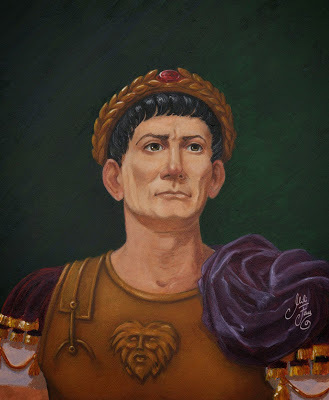 "Emperor Trajan"
"Emperor Trajan"
 "Animals In My Hair" Cover
"Animals In My Hair" Cover
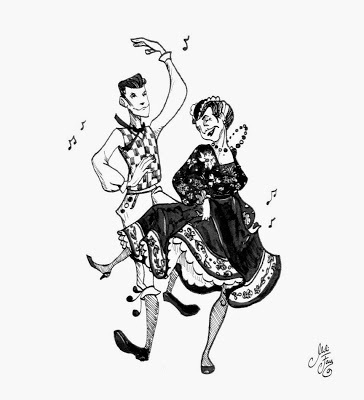 "Dancing Grandma"
"Dancing Grandma"
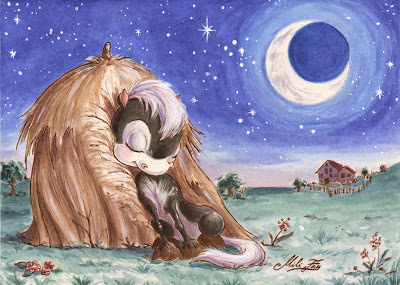 Horsing Around: "Dream, Little Dreamer"
Horsing Around: "Dream, Little Dreamer"
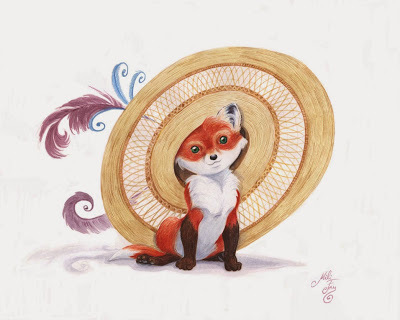 Award Winning "Fox"
Award Winning "Fox"
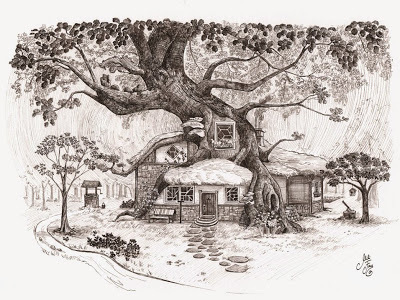 "Warriors of Virtue"
"Warriors of Virtue"
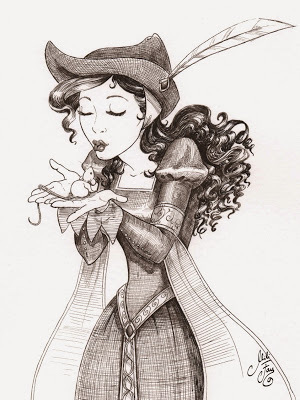 "Warriors of Virtue"
"Warriors of Virtue"
 "Elle Burton and the Reflective Portals" Front Cover
"Elle Burton and the Reflective Portals" Front Cover
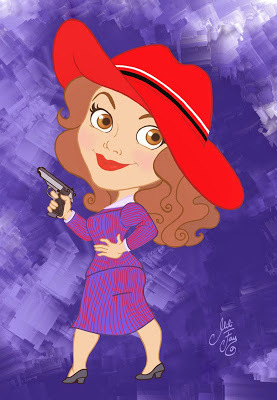 Marvel's Agen CarterDiversity. Would the illustrator’s work stand out from the wall of books at your local store, or would it blend in?
Marvel's Agen CarterDiversity. Would the illustrator’s work stand out from the wall of books at your local store, or would it blend in? Remember all the research you have done at your local book store? This should give you the idea whether the illustrator you are considering would be the perfect fit for your project. If his/her work is too similar to books already at the store, you may wish to find another illustrator.
Dedication. Is the illustrator excited about your project, or is it only a job?
Professional illustrators draw constantly. Eventually, the projects they encounter may lack novelty and appear repetitive. Even when jaded, professionals would produce excellent work. However, if you can get them excited about the project, then their soul, joy, and passion will be captured in the artwork. For example, recently I illustrated the cover for Peggy M. McAloon’s Elle Burton and the Reflective Portals . I love this book; I love Peggy’s idea and what she wants to achieve with her book; I love fantasy; and I love drawing people. I was given free reign to create. As a result, the project was pure joy and I could hardly wait to work on the illustrations every day. Now, if someone asked me to draw a bunch of FBI guys leaping out of a helicopter, guns drawn, fighting with machines… I could create a strong, action-packed illustration, but I would not enjoy it. I do not like drawing machines, buildings, and weapons (unless they are medieval). The only bit from that project I may like drawing are the people, but these people would also have the same body type and clothing—boring! Bottom line, if an illustrator is excited about your work, everything about the process will rock!
Professionalism. If an artist gives you a deadline, they should produce the work by that deadline.
Sometimes the unpredictable happens; such as my computer dying the first time I decided to create an all-digital illustration. However, the artist should inform you immediately of circumstances that may cause delays. There should at least be a simple agreement between you and the illustrator, outlining what you can expect to receive and when. Pay special attention to revisions. In order to maintain focus and keep the project moving swiftly, I give my clients only one or two free revisions. Bottom line, working with a great illustrator will result in a professional collaboration.
HOOTs Of Wisdom
Where to find your illustrator?
No budget. Your only hope is a family friend with lots of time on their hands.
Approaching an illustrator with a promise to give him/her a percentage of future proceeds (the stars and the moon) if they illustrate your book for free will always result in a: NO. Illustrators are professionals and they do not work for free. Self-published books from unknown authors are useless or illustrators' credibility and portfolios. The only time an illustrator may work for free is if you are a major celebrity and they know there are millions of people awaiting your book. For example, if Neil Gaiman asked me to illustrate his cover for free in exchange for 20% of his income from the book, I would say: “OMG, it’s Neil Gaiman!!!... I mean: Yes, Master.”
Low Budget. I have sometimes seen authors get excited, because they can get an illustration for five dollars on Fiver, or they cut and paste images with a computer program to create their own illustrations. To this, all I can say is: you get what you pay for.
As a self-published author your work must at least match trade publications, if not surpass them, if you want your book to succeed.
If you cannot afford a professional illustrator, I suggest you save up until you can. Even someone who is a good artist, may not be a good illustrator. If your story is that great, try to raise money through Kickstarter or find investors.
If you do not want to wait, visit schools that train illustrators/artists. The students will soon be professionals and they will likely be able to create excellent work for a smaller fee than an already established illustrator. The first professional illustration job I got was in my first year of college when I won the contest to illustrate a poster for Bone Wellness’ Osteoporosis Galla. I painted two dressed up skeletons dancing and my clients got the poster, original painting, as well as the copyright for $500. If I charged them as a professional illustrator for that project, I would have given them the poster for $1000, but kept the original painting and copyright. If they wanted the painting, I would have charged an additional $500. For everything I would have charged $3000.
Professional Budget. From the previous article you may be able to calculate what a professional illustrator would charge. If you have a professional budget, you can find thousands of illustrators online.
My advice is to search trough DeviantArt . I’m not sure, but I think this is the largest database of artists in the world. You can search the site by genre, subject, etc. In the profile section, you’ll be able to to read about the artist. In the comments you can see how the person reacts to criticism, what others think of him/her,... There are a lot of amateur artists, but you can also find famous professionals. Then, there are a lot of artists who are professionals, but are not yet famous. Here you will strike gold. If you hire an artist to illustrate your book before they become famous… Sky is the limit.
A new database of professional artists is ArtStation . I have not explored this site as much, but you may wish to try it out.
You can discover further artists on Pinterest, Tumblr, Instagram, Twitter, Facebook,…
You can meet them in LinkedIn Groups. I belong to several illustration and publishing groups.
You can always Google “illustrators database” and add the word for what kind of illustration you are looking for. Example: I searched for “children’s illustrators database” and got the following websites:
http://www.childrensillustrators.com
https://www.scbwi.org/illustrator-gallery/
*****And there you have it; the latest HOOTs of Wisdom!
As always, if you have any questions do not hesitate to contact me . If you would like to hire me, I’m sincerely flattered, but currently I’m not looking for additional projects. However, I will be interested in illustrating and designing book covers for fiction chapter books: fantasy, romance, young adult, and mystery. To get yourself on the waiting list, please send me an email describing your work and what you would like me to illustrate, samples of book covers you like, and any other information you think would help me decide that I am your perfect illustrator.
Wishing you only the best!
Mili
*It can be any illustration project, but let’s pretend in this case it's a book.
**If your book is to be digital only, make sure you research Amazon.com, and whatever other platform you intend to sell your book through.
-----------------------------------------

Mili Fay, a Toronto-based artist, classical animator, illustrator, writer, and singer, is an award winning graduate of Sheridan College and Art Instruction Schools. In November of 2011 she created Mili Fay Art determined to support the world one artwork at a time.
Her latest published work is Animals In My Hair ; a story about a boy who goes for his first haircut only to find endangered animals falling out of his hair. Presented at INSPIRE! Toronto International Book Fair (November 14, 2014) out of 700+ submissions, Animals In My Hair, is the world’s first ever Artwork Book; a new type of picture book that seamlessly combines the best features of fine art, picture books, activity books, and educational books.
In accordance with Mili Fay Art’s vision, 30% of all profits from Animals In My Hair book and merchandise will be donated to wildlife conservation.
Join Mili Fay Art Fan Club to stay in touch with Mili Fay and to be the first to find out of her upcoming books and artworks.
Mili Fay Art: “Together we support the world one artwork at a time.”
Published on May 04, 2015 18:16
January 29, 2015
Illustration Process: How Much Should I Pay/Charge For Illustration?
I was invited by Connie Dunn to write a column for her new online magazine. After much deliberation, I decided to call my column "Mili Fay's Hoots Of Wisdom". I will connect you all to the magazine as soon as it is live, but for now enjoy the article and let me know what you think.
Cheers!
M
------------------------------------

ILLUSTRATION PROCESS
How Much Should I Pay/Charge For Illustration?
Please allow me to introduce myself: I’m Mili Fay, the creator of Mili Fay Art, artist, illustrator, animator, writer, and sometimes singer. My vision is to use the gifts I was given to make the world a better place one artwork at a time. You can find out more about me by visiting www.artofmili.ca, by Googling my name, or by direct inquiry via social media. When Connie Dunn approached me about writing a column for Weeping Cherry International Review, I was thrilled to be offered the opportunity. There is always more I need to learn. However, working as a freelancer since I was fourteen, I managed to gather a few seeds of wisdom I’m happy to share. Therefore, in this column I will share with you completely biased, yet Honest Open Operative Tips (HOOTs) of Wisdom. Feel free to correct me, share your opinions, or to contact me with questions you would like to have answered in the future.
In my debut column, I will try to answer a question I have seen repeatedly in LinkedIn Groups regarding illustration. Before I do so, let me share with you some relevant personal experience.
After deciding that I prefer drawing to animating on a computer, I attempted to break into the illustration field. As a naïve graduate I expected prospective employers to treat me as a professional. I was confident, because I graduated at the top of my class, capable of scaling every barrier. However, I soon realised that illustration is a vicious money-crunching business like any other. My skills mattered little, and the only jobs I could find were the ones offering payment well below minimum wage. I was a young illustrator working for free or low wages to gain “experience”, only to discover that the experience I gained was not the “right kind of experience.”
If you are an illustrator, how many times were you asked to partner up with an unknown author for a chance to illustrate his/her book for free?
How many times were you approached by non-profit organizations asking you to volunteer your services?
Once, I was asked to illustrate a “full-colour, Disney-style” picture book for $500!
What other ridiculous offers have YOU received in the past?
Upon receiving one of the above offers, I politely declined them while fuming inside at the other party for wasting my time. Then one day I stopped fuming, because I suddenly realised that most of the individuals who were making these offers where not evil opportunists; they were simply ignorant.
What does an average person know about illustration?
I’m sure that everyone who is not an artist, or who does not live with an artist, has an image of their grade school classmate producing a coloured drawing within an hour or two. They may remember sitting as children and drawing pictures during their spare time; an artistic friend giving them a drawing of their favourite super-hero; a kid in their class who created pages and pages of comics during recess. Drawing is fun! Drawing is easy.
If a child can produce all those drawings in such a short amount of time, why couldn't an illustrator with years of professional training create even better pictures faster?
Sadly, the illustration process is not the same as a child drawing and colouring a picture during play-time.
So, what is this illustration process?
In my experience the illustration process differs somewhat depending on whether the author and the illustrator are the same person, partners, or complete strangers. For the purpose of this column I will tackle the last; I will pretend that I have received a picture book manuscript and that I’m in charge of getting this book ready for publishing.
*****
Illustration Process: When The Illustrator And The Author Are Complete Strangers
Step 1: Read The Manuscript And Figure Out The Number Of Illustrations Needed
As an illustrator, I will first read the complete manuscript. Then, I will read it again trying to visualise possible pages. Standard length for a picture book is 24 or 32 pages, because the signatures (sections of bound pages that make up the book) tend to come in lengths of 12 or 16 pages. Other than the length of the book, I also need to take into account the front and back matter of every professionally published book; i.e. copyright page, blank pages, title page, dedication page... Furthermore, I know that there are two pages at the beginning and end of the story that will be single page illustrations (usually of vertical layout, unless the entire book is of a landscape format), while the remainder of the book will be made up of two-page spreads (requiring horizontal layout). For this example, let us say that our fictitious picture book is 32 pages in length. Let us also assume that the front matter for the book is a Dedication Page, a Copyright Page, and a Title Page. The book has no back matter. This means that I am left with 28 pages (32 – 4 = 28). The first and last page are a vertical layout, and the remainder are two-page spreads. Therefore, I have to create 15 illustrations (2 + (26/2) = 15). I also have to design the cover.
Step 2: Thumbnail Sketches
Thumbnail sketches are tiny notes we artists make for ourselves. They are not meant for another's eyes, and therefore they rarely make sense to anyone other than the artist. As I am reading the manuscript a third time, I will begin creating possible thumbnail sketches of each illustration. Sometimes I can see exactly what I want, and sometimes I need to create dozens of these sketches for a single illustration.
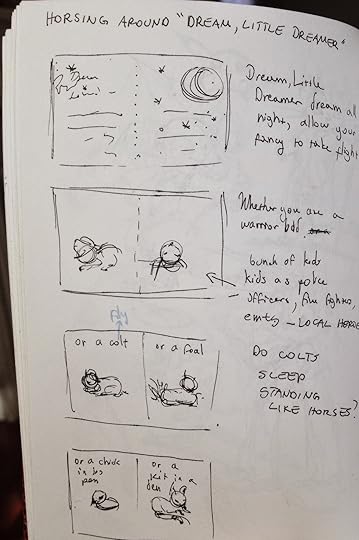 Thumbnail Sketches for "Dream, Little Dreamer"
Thumbnail Sketches for "Dream, Little Dreamer"
Step 3: Research and Design
After figuring out the number of illustrations and drawing the thumbnail sketches, I would probably contact the author. As an illustrator my job is to take the author’s vision, not mine, and make it better.
After the conversation with the author, I will begin my research.
Google is probably the greatest invention for us artists since cavemen figured out how to create paint. Before Google, artists had to go to libraries, they had to rifle through dozens upon dozens of stock photos, books, and maybe even film, before they could find the necessary visual references. Today, I type what I need into Google’s search engine and in seconds I have relevant visual information spread out before me.
Most illustrators have their own style , a commercial look that they are known for in the industry. Since I was trained as an animator, I do not like to keep myself to a single visual style. I believe that the style/look of the book should reflect the story. Therefore, I approach each new project with fresh eyes. If a story is dark, I may choose a blue/purple palette, more angular lines, and high contrasting shadows… If a story is meant for young children, characters will have simple shapes and bright colours… For a romantic story, I may use flowing lines with pinks and purples…
Let's say that the story I am illustrating is about a girl who visits her friend's homes and discovers each friend's unique culture. First of all I will need to “cast” my girl. I will look through several dozen pictures of girls on Google, sketching until I have a rough design of my heroine.
While designing, I may ask myself the following questions:
What will my heroine wear? What culture is she from? Will she have jewellery? A ribbon in her hair? Will she wear a dress, pants, shorts, or a school uniform?
Then my designing and research expands.
How many friends will she visit? What do they look like? What are their homes like? If one of her friends is an athlete and she is visiting her friend’s room, what furniture, posters, toys, etc. will she find there?
What do I need to draw to make the reader feel immersed in each character’s culture?
Researching and designing continues until I have all the necessary characters, props, and background designs. The more characters and different settings a book has, the more time it will take for me to complete my research and design stage of the illustration process.
In the fast-paced publishing industry Art Director/Editor matches the manuscript to an illustrator’s particular style. An illustrator rarely gets to speak with the author, he/she communicates through the Art Director/Editor.
I prefer to communicate with the author, because the story is ultimately the author’s vision, and the illustrations are there to support this vision, not the other way around. Therefore, while researching and designing, I will always keep the author aware of what I’m working on, and eventually we will create a look that will make both of us happy, a look that would probably be better than if we have never met at all.
Step 4: Layout
Taking all of the materials collected so far, I will reread the story again and make more detailed sketches of each illustration. I will keep in mind the layout of each scene leaving a blank, or uncluttered, area for the text. Once this is figured out, I will make cleaner (sketches with a neater line and/or more detail) sketches of each. Then, I will send these sketches to the Art Director for approval. However, since in this case I am my own Art Director, I will stop the project for a few days and then look at what I have with fresh eyes, or I will send the sketches to the author and see if he/she has some suggestions. It is only after the layout sketches have been approved that I can begin to illustrate the book.
Step 5: Illustration
To illustrate this part of the process, I will use the artwork I have created while illustrating a two-page spread for my book, “Animals In My Hair”. Please note that I usually pick the scene I am absolutely sure of and work on that illustration first; I never illustrate in order.
 This is the original thumbnail sketch for the illustration.
This is the original thumbnail sketch for the illustration.
 This is a thumbnail sketch I created when I have decided to make the numbers reflect the habitat.
This is a thumbnail sketch I created when I have decided to make the numbers reflect the habitat.
 This is a rough sketch where I'm trying to figure out the composition.
This is a rough sketch where I'm trying to figure out the composition.
 This is the final rough layout sketch.
Part I: Drawing 1
This is the final rough layout sketch.
Part I: Drawing 1
Once I had the final layout for the illustration of the owls, I began to draw. I redrew the image in a larger size, working out placements and adding some details.
Part II: Scan 1 and Size 1
I scanned the drawing, and made sure that it fit the printing ratio (For example, if the printed image is to be 4” x 6”, I can choose to draw it at 8” x 12”, or any multiple of the 2:3 ratio. The more details that the drawing has, the larger my image has to be. If I was working digitally, I would keep the size slightly bigger than the print size and at least 600 ppi. I will never draw the image smaller than the print size, because to fit the print size I would digitally have to upscale the image, resulting in thicker, messier lines. It is better to draw your images bigger than the print size if you can, because scaling down will make your lines look neater and finer.). For “Animals In My Hair” the print size of a two-page spread is 18” x 12”. To this I added the extra ¼” bleed on the outside, making the actual image to be printed 18.5” x 12.5”. However, at this stage I sized the image to fit the 14” x 17” layout paper I used for drawing then printed the image.
 Part I and Part II has been completed.
Part III: Drawing 2
Part I and Part II has been completed.
Part III: Drawing 2
Using a light table , I traced the image onto a clean sheet of layout paper, making improvements and adding more details as I drew. (For this step I usually use a blue col-erase pencil.)
Part IV: Clean-Up
Once I was satisfied with the blue-pencil drawing I traced over the lines I need with a pen, continually improving and adding details to the image. (I usually use a black pen.)
 Part III and Part IV. In this case I have used the purple col-erase pencil and have cleaned-up with a blue pen.
Part V: Scan 2 and Size 2
Part III and Part IV. In this case I have used the purple col-erase pencil and have cleaned-up with a blue pen.
Part V: Scan 2 and Size 2
I scanned the pen-traced drawing and then sized it to fit my painting medium (in this case an 11” x 14” rag drawing paper), maintaining the printing ratio. If I had a larger light table and scanner, I would create final paintings to fit the scanner's size. However in my case the 18.5” x 12.5” two-page spread had to be divided in two, so that in the end I ended up with two printouts of approximately 10” x 13.3” (the combined two-page spread now being 20” x 13.3”, slightly bigger than print size, which is how I like to work).
Part VI: Tracing, Clean-up 2, Final Tracing
On another layout paper, I carefully traced every line of the print, so that the divided illustration matched as closely as possible at the dividing edge. Then I cleaned-up the drawing again, before placing it under a blank rag drawing paper and tracing the final image with a crow-quill dip pen and acrylic ink.
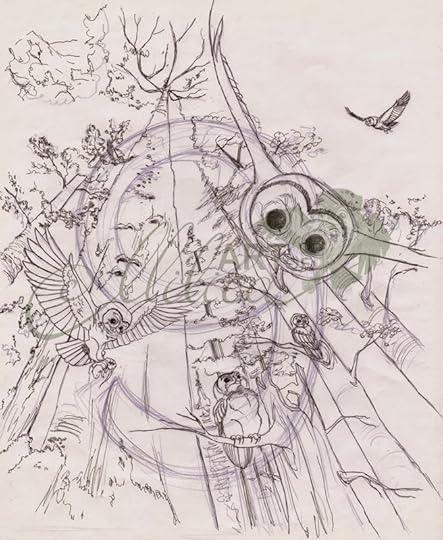 Part V and Part VI. Unfortunately, I forgot to take a photo of the clean ink line.
Part VII: Painting
Part V and Part VI. Unfortunately, I forgot to take a photo of the clean ink line.
Part VII: Painting
I took my final traced drawing, stuck it to the board with painter’s tape (dark green), and then began to paint. As you can see, I have used watercolour. Painting a full-colour illustration such as the owls took about a week.
 I paint in thin layers, allowing the pigment to settle to the bottom of the tray and painting with the coloured water that is left on top. You can see some of the clean ink line in this image.
I paint in thin layers, allowing the pigment to settle to the bottom of the tray and painting with the coloured water that is left on top. You can see some of the clean ink line in this image.



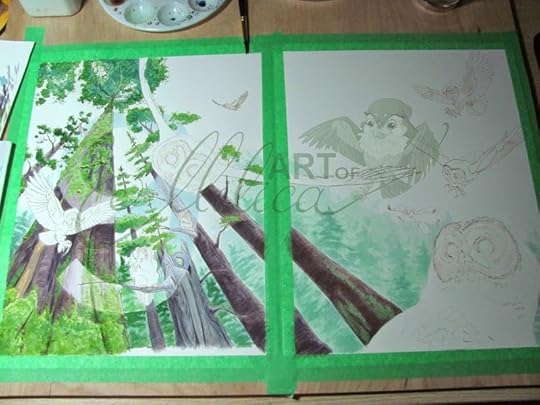
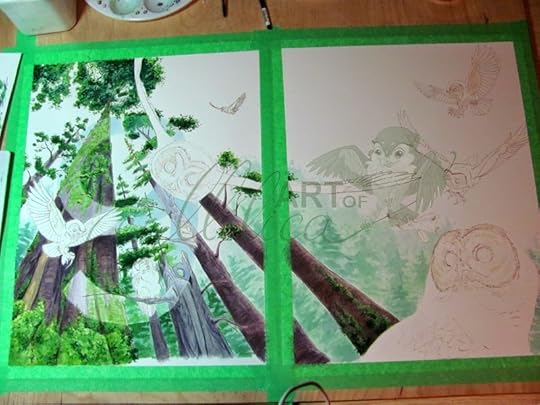


Part VIII: Clean-up 3
Because the paint covered the original ink line, I had to go back and re-ink the entire illustration. At the very end I added highlights with opaque white paint.
 Finished Painting
Part IX: Scan 3
Finished Painting
Part IX: Scan 3
Once the painting was dry, I scanned it at 300 ppi (600 ppi is better, but my computer was too old to process that many MBs).
Part X: Image Editing
For "Animals In My Hair" I had access to Photoshop CS5. I opened the two image scans in the program and attached them together. It did not matter how careful I was while tracing and painting, the two divided images of any illustration never lined up perfectly. I therefore used the Clone-Stamp Tool to fix the illustration.
Part XI: Add text and Size 3
Once the image was perfect, I used the Type Tool to add text. I sized the image, making sure to leave room for the outside bleed and the inner seam, so after the text was added the image was ready to be printed. I saved the image in RGB Mode for digital purposes (sans outside bleed), and also in CMYK Mode which I then sent to my printer in PDF format.
 Final Illustration in RGB Mode Step 6: Repeat Step 5 until every illustration is done, including the Cover.
Final Illustration in RGB Mode Step 6: Repeat Step 5 until every illustration is done, including the Cover.
*****
I have never had a job where the work went according to plan. I had clients making changes resulting in delays. I had equipment dying and having to rework from a certain saved point. I had a glob of ink fall onto my illustration after I have spent hours painting it. I got sick. I had family emergencies... Life happens causing delays and deadlines to be pushed back.
As you can see, illustrating a book is far different than being a child drawing pictures in your spare time. It is a real job that requires more than artistic skills.
So, what do you think an illustrator should be paid to illustrate a picture book?
How can an employer figure out a fair wage before they approach an illustrator for a job?
There are two main factors that determine the price of an illustration job (or any creative job): Time and Quality.
I was shown a great diagram a while back that illustrates this concept, and it went something like this:
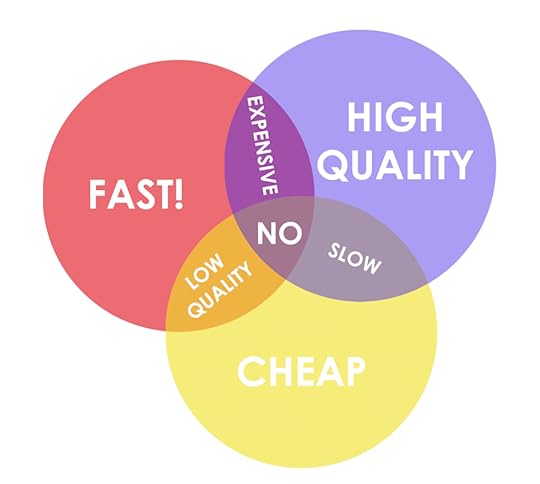
An employer can pick any of the two sets. Picking all three sets is usually impossible, because anyone who produces quality work quickly will not be cheap. If someone agrees, an employer can be sure that their work will be of only acceptable, not competitive quality, or that this person is too naïve to know any better. In the last case, the employer managed to take unscrupulous advantage of the employee. Congratulations!
There is another factor that determines the price, and that is fame. The more famous an artist is, the more expensive his/her time will be. To get the best price for the best work, a truly visionary employer will find these talented artists before they have managed to make a name for themselves and use them until they become famous, or have been drained of all creativity.
For those employers who do not support slavery, here is a way they can calculate a fair wage for an illustrator. Illustrators when you are accepting a wage, please be aware of these factors.
According to livingin-canada.com the average wage for someone working as an illustrator in Toronto, Ontario is CND$26.25. An employee of greater skill will cost more, and employee of lesser skill may accept less.
As an employer, will you offer your employee benefits? Freelancers have to pay for their own benefits, so if you are planning to offer the position to a freelancer, make sure you add the adequate amount to the hourly wage.
Will your employee be working at a set work schedule, or will he/she have to work overtime? Add on the cost.
Is your deadline flexible? Can the employee work on your project in his/her spare time? You may be able to negotiate for less money.
Once you have an hourly rate you feel is acceptable, you can calculate the set fee for a particular project. Consider the illustration process I have shared with you, determine how many hours it will take to complete the said project, and multiply. However, always have an extra third of the calculated fee available in case of delays and unexpected changes. This will give you the budget with which you can approach your prospective illustrator.
Using our 32 page picture book as an example, let’s say that each illustration takes a week to illustrate. We have 15 illustrations plus the cover; 16 illustrations in total. Therefore, the project will take 16 weeks to illustrate. In my animation studies I have read that the time it takes for designers to design the movie, equals the production of the movie. Following this logic we will add on 16 more weeks, making the total time of the project equal 32 weeks. An average work week is about 40 hours. Therefore, the project will be 1280 hours long. Let’s say our fair wage is $30/h. This particular book will therefore cost $38 400. Add on a third for unforeseen expenses, and you should have an available budget of $51 200 for this one book.
HOOTs of Wisdom
As an employer, what can you do to make your illustrator’s job easier, which will result in you saving more money?
Research. There is no need for the illustrator to do all the research. Search Google Images yourself until you have a complete vision for your illustrations. Early in my illustration career I have illustrated for a non-profit French language school. The employer did not have much of a budget, but we negotiated free lessons, and he had pages and pages of printouts of what he envisioned for each illustration. As a result I knew exactly what he wanted, and was able to produce each illustration faster.
Trust. Trust your illustrator. You have hired him/her to illustrate for you because you admire his/her skills. Therefore, do not try to micro-manage every illustration. Do not allow an illustration to progress beyond the sketching stage and then ask for revisions.
Details? How detailed do the illustrations have to be? Do they need to be in colour? Do you need a scene involving many characters? Do you need the background? The more an illustrator has to draw, the more time it will take him/her to do so. In animation, we were taught early on about line mileage ; the more lines your character has, the more time it will take for an animator to animate the character, resulting in greater expense. Also the more colours a character has, the longer it takes for the painter to colour the character. The same principles apply to illustration. Consider the job. Do you really need those “Disney-style, full-colour” illustrations, or can your story be told with simple appealing designs such as Ruth Ohi creates?
Be honest. Do not try to trick your illustrator. If you have a low budget, ask your illustrator what he/she can do with the illustrations to make the work fit the budget.
*****
There you have it; my first HOOTs of Wisdom. I hope that you have enjoyed reading this column. If you have any questions, suggestions, or complements, please do not hesitate to contact me.
-----------------------------------------

Mili Fay, a Toronto-based artist, classical animator, illustrator, writer, and singer, is an award winning graduate of Sheridan College and Art Instruction Schools. In November of 2011 she created Mili Fay Art determined to support the world one artwork at a time.
Her latest published work is Animals In My Hair ; a story about a boy who goes for his first haircut only to find endangered animals falling out of his hair. Presented at INSPIRE! Toronto International Book Fair (November 14, 2014) out of 700+ submissions, Animals In My Hair, is the world’s first ever Artwork Book; a new type of picture book that seamlessly combines the best features of fine art, picture books, activity books, and educational books.
In accordance with Mili Fay Art’s vision, 30% of all profits from Animals In My Hair book and merchandise will be donated to wildlife conservation.
Join Mili Fay Art Fan Club to stay in touch with Mili Fay and to be the first to find out of her upcoming books and artworks.
Mili Fay Art: “Together we support the world one artwork at a time.”
Cheers!
M
------------------------------------

ILLUSTRATION PROCESS
How Much Should I Pay/Charge For Illustration?
Please allow me to introduce myself: I’m Mili Fay, the creator of Mili Fay Art, artist, illustrator, animator, writer, and sometimes singer. My vision is to use the gifts I was given to make the world a better place one artwork at a time. You can find out more about me by visiting www.artofmili.ca, by Googling my name, or by direct inquiry via social media. When Connie Dunn approached me about writing a column for Weeping Cherry International Review, I was thrilled to be offered the opportunity. There is always more I need to learn. However, working as a freelancer since I was fourteen, I managed to gather a few seeds of wisdom I’m happy to share. Therefore, in this column I will share with you completely biased, yet Honest Open Operative Tips (HOOTs) of Wisdom. Feel free to correct me, share your opinions, or to contact me with questions you would like to have answered in the future.
In my debut column, I will try to answer a question I have seen repeatedly in LinkedIn Groups regarding illustration. Before I do so, let me share with you some relevant personal experience.
After deciding that I prefer drawing to animating on a computer, I attempted to break into the illustration field. As a naïve graduate I expected prospective employers to treat me as a professional. I was confident, because I graduated at the top of my class, capable of scaling every barrier. However, I soon realised that illustration is a vicious money-crunching business like any other. My skills mattered little, and the only jobs I could find were the ones offering payment well below minimum wage. I was a young illustrator working for free or low wages to gain “experience”, only to discover that the experience I gained was not the “right kind of experience.”
If you are an illustrator, how many times were you asked to partner up with an unknown author for a chance to illustrate his/her book for free?
How many times were you approached by non-profit organizations asking you to volunteer your services?
Once, I was asked to illustrate a “full-colour, Disney-style” picture book for $500!
What other ridiculous offers have YOU received in the past?
Upon receiving one of the above offers, I politely declined them while fuming inside at the other party for wasting my time. Then one day I stopped fuming, because I suddenly realised that most of the individuals who were making these offers where not evil opportunists; they were simply ignorant.
What does an average person know about illustration?
I’m sure that everyone who is not an artist, or who does not live with an artist, has an image of their grade school classmate producing a coloured drawing within an hour or two. They may remember sitting as children and drawing pictures during their spare time; an artistic friend giving them a drawing of their favourite super-hero; a kid in their class who created pages and pages of comics during recess. Drawing is fun! Drawing is easy.
If a child can produce all those drawings in such a short amount of time, why couldn't an illustrator with years of professional training create even better pictures faster?
Sadly, the illustration process is not the same as a child drawing and colouring a picture during play-time.
So, what is this illustration process?
In my experience the illustration process differs somewhat depending on whether the author and the illustrator are the same person, partners, or complete strangers. For the purpose of this column I will tackle the last; I will pretend that I have received a picture book manuscript and that I’m in charge of getting this book ready for publishing.
*****
Illustration Process: When The Illustrator And The Author Are Complete Strangers
Step 1: Read The Manuscript And Figure Out The Number Of Illustrations Needed
As an illustrator, I will first read the complete manuscript. Then, I will read it again trying to visualise possible pages. Standard length for a picture book is 24 or 32 pages, because the signatures (sections of bound pages that make up the book) tend to come in lengths of 12 or 16 pages. Other than the length of the book, I also need to take into account the front and back matter of every professionally published book; i.e. copyright page, blank pages, title page, dedication page... Furthermore, I know that there are two pages at the beginning and end of the story that will be single page illustrations (usually of vertical layout, unless the entire book is of a landscape format), while the remainder of the book will be made up of two-page spreads (requiring horizontal layout). For this example, let us say that our fictitious picture book is 32 pages in length. Let us also assume that the front matter for the book is a Dedication Page, a Copyright Page, and a Title Page. The book has no back matter. This means that I am left with 28 pages (32 – 4 = 28). The first and last page are a vertical layout, and the remainder are two-page spreads. Therefore, I have to create 15 illustrations (2 + (26/2) = 15). I also have to design the cover.
Step 2: Thumbnail Sketches
Thumbnail sketches are tiny notes we artists make for ourselves. They are not meant for another's eyes, and therefore they rarely make sense to anyone other than the artist. As I am reading the manuscript a third time, I will begin creating possible thumbnail sketches of each illustration. Sometimes I can see exactly what I want, and sometimes I need to create dozens of these sketches for a single illustration.
 Thumbnail Sketches for "Dream, Little Dreamer"
Thumbnail Sketches for "Dream, Little Dreamer"Step 3: Research and Design
After figuring out the number of illustrations and drawing the thumbnail sketches, I would probably contact the author. As an illustrator my job is to take the author’s vision, not mine, and make it better.
After the conversation with the author, I will begin my research.
Google is probably the greatest invention for us artists since cavemen figured out how to create paint. Before Google, artists had to go to libraries, they had to rifle through dozens upon dozens of stock photos, books, and maybe even film, before they could find the necessary visual references. Today, I type what I need into Google’s search engine and in seconds I have relevant visual information spread out before me.
Most illustrators have their own style , a commercial look that they are known for in the industry. Since I was trained as an animator, I do not like to keep myself to a single visual style. I believe that the style/look of the book should reflect the story. Therefore, I approach each new project with fresh eyes. If a story is dark, I may choose a blue/purple palette, more angular lines, and high contrasting shadows… If a story is meant for young children, characters will have simple shapes and bright colours… For a romantic story, I may use flowing lines with pinks and purples…
Let's say that the story I am illustrating is about a girl who visits her friend's homes and discovers each friend's unique culture. First of all I will need to “cast” my girl. I will look through several dozen pictures of girls on Google, sketching until I have a rough design of my heroine.
While designing, I may ask myself the following questions:
What will my heroine wear? What culture is she from? Will she have jewellery? A ribbon in her hair? Will she wear a dress, pants, shorts, or a school uniform?
Then my designing and research expands.
How many friends will she visit? What do they look like? What are their homes like? If one of her friends is an athlete and she is visiting her friend’s room, what furniture, posters, toys, etc. will she find there?
What do I need to draw to make the reader feel immersed in each character’s culture?
Researching and designing continues until I have all the necessary characters, props, and background designs. The more characters and different settings a book has, the more time it will take for me to complete my research and design stage of the illustration process.
In the fast-paced publishing industry Art Director/Editor matches the manuscript to an illustrator’s particular style. An illustrator rarely gets to speak with the author, he/she communicates through the Art Director/Editor.
I prefer to communicate with the author, because the story is ultimately the author’s vision, and the illustrations are there to support this vision, not the other way around. Therefore, while researching and designing, I will always keep the author aware of what I’m working on, and eventually we will create a look that will make both of us happy, a look that would probably be better than if we have never met at all.
Step 4: Layout
Taking all of the materials collected so far, I will reread the story again and make more detailed sketches of each illustration. I will keep in mind the layout of each scene leaving a blank, or uncluttered, area for the text. Once this is figured out, I will make cleaner (sketches with a neater line and/or more detail) sketches of each. Then, I will send these sketches to the Art Director for approval. However, since in this case I am my own Art Director, I will stop the project for a few days and then look at what I have with fresh eyes, or I will send the sketches to the author and see if he/she has some suggestions. It is only after the layout sketches have been approved that I can begin to illustrate the book.
Step 5: Illustration
To illustrate this part of the process, I will use the artwork I have created while illustrating a two-page spread for my book, “Animals In My Hair”. Please note that I usually pick the scene I am absolutely sure of and work on that illustration first; I never illustrate in order.
 This is the original thumbnail sketch for the illustration.
This is the original thumbnail sketch for the illustration. This is a thumbnail sketch I created when I have decided to make the numbers reflect the habitat.
This is a thumbnail sketch I created when I have decided to make the numbers reflect the habitat. This is a rough sketch where I'm trying to figure out the composition.
This is a rough sketch where I'm trying to figure out the composition. This is the final rough layout sketch.
Part I: Drawing 1
This is the final rough layout sketch.
Part I: Drawing 1
Once I had the final layout for the illustration of the owls, I began to draw. I redrew the image in a larger size, working out placements and adding some details.
Part II: Scan 1 and Size 1
I scanned the drawing, and made sure that it fit the printing ratio (For example, if the printed image is to be 4” x 6”, I can choose to draw it at 8” x 12”, or any multiple of the 2:3 ratio. The more details that the drawing has, the larger my image has to be. If I was working digitally, I would keep the size slightly bigger than the print size and at least 600 ppi. I will never draw the image smaller than the print size, because to fit the print size I would digitally have to upscale the image, resulting in thicker, messier lines. It is better to draw your images bigger than the print size if you can, because scaling down will make your lines look neater and finer.). For “Animals In My Hair” the print size of a two-page spread is 18” x 12”. To this I added the extra ¼” bleed on the outside, making the actual image to be printed 18.5” x 12.5”. However, at this stage I sized the image to fit the 14” x 17” layout paper I used for drawing then printed the image.
 Part I and Part II has been completed.
Part III: Drawing 2
Part I and Part II has been completed.
Part III: Drawing 2
Using a light table , I traced the image onto a clean sheet of layout paper, making improvements and adding more details as I drew. (For this step I usually use a blue col-erase pencil.)
Part IV: Clean-Up
Once I was satisfied with the blue-pencil drawing I traced over the lines I need with a pen, continually improving and adding details to the image. (I usually use a black pen.)
 Part III and Part IV. In this case I have used the purple col-erase pencil and have cleaned-up with a blue pen.
Part V: Scan 2 and Size 2
Part III and Part IV. In this case I have used the purple col-erase pencil and have cleaned-up with a blue pen.
Part V: Scan 2 and Size 2
I scanned the pen-traced drawing and then sized it to fit my painting medium (in this case an 11” x 14” rag drawing paper), maintaining the printing ratio. If I had a larger light table and scanner, I would create final paintings to fit the scanner's size. However in my case the 18.5” x 12.5” two-page spread had to be divided in two, so that in the end I ended up with two printouts of approximately 10” x 13.3” (the combined two-page spread now being 20” x 13.3”, slightly bigger than print size, which is how I like to work).
Part VI: Tracing, Clean-up 2, Final Tracing
On another layout paper, I carefully traced every line of the print, so that the divided illustration matched as closely as possible at the dividing edge. Then I cleaned-up the drawing again, before placing it under a blank rag drawing paper and tracing the final image with a crow-quill dip pen and acrylic ink.
 Part V and Part VI. Unfortunately, I forgot to take a photo of the clean ink line.
Part VII: Painting
Part V and Part VI. Unfortunately, I forgot to take a photo of the clean ink line.
Part VII: Painting
I took my final traced drawing, stuck it to the board with painter’s tape (dark green), and then began to paint. As you can see, I have used watercolour. Painting a full-colour illustration such as the owls took about a week.
 I paint in thin layers, allowing the pigment to settle to the bottom of the tray and painting with the coloured water that is left on top. You can see some of the clean ink line in this image.
I paint in thin layers, allowing the pigment to settle to the bottom of the tray and painting with the coloured water that is left on top. You can see some of the clean ink line in this image.






Part VIII: Clean-up 3
Because the paint covered the original ink line, I had to go back and re-ink the entire illustration. At the very end I added highlights with opaque white paint.
 Finished Painting
Part IX: Scan 3
Finished Painting
Part IX: Scan 3
Once the painting was dry, I scanned it at 300 ppi (600 ppi is better, but my computer was too old to process that many MBs).
Part X: Image Editing
For "Animals In My Hair" I had access to Photoshop CS5. I opened the two image scans in the program and attached them together. It did not matter how careful I was while tracing and painting, the two divided images of any illustration never lined up perfectly. I therefore used the Clone-Stamp Tool to fix the illustration.
Part XI: Add text and Size 3
Once the image was perfect, I used the Type Tool to add text. I sized the image, making sure to leave room for the outside bleed and the inner seam, so after the text was added the image was ready to be printed. I saved the image in RGB Mode for digital purposes (sans outside bleed), and also in CMYK Mode which I then sent to my printer in PDF format.
 Final Illustration in RGB Mode Step 6: Repeat Step 5 until every illustration is done, including the Cover.
Final Illustration in RGB Mode Step 6: Repeat Step 5 until every illustration is done, including the Cover.
*****
I have never had a job where the work went according to plan. I had clients making changes resulting in delays. I had equipment dying and having to rework from a certain saved point. I had a glob of ink fall onto my illustration after I have spent hours painting it. I got sick. I had family emergencies... Life happens causing delays and deadlines to be pushed back.
As you can see, illustrating a book is far different than being a child drawing pictures in your spare time. It is a real job that requires more than artistic skills.
So, what do you think an illustrator should be paid to illustrate a picture book?
How can an employer figure out a fair wage before they approach an illustrator for a job?
There are two main factors that determine the price of an illustration job (or any creative job): Time and Quality.
I was shown a great diagram a while back that illustrates this concept, and it went something like this:

An employer can pick any of the two sets. Picking all three sets is usually impossible, because anyone who produces quality work quickly will not be cheap. If someone agrees, an employer can be sure that their work will be of only acceptable, not competitive quality, or that this person is too naïve to know any better. In the last case, the employer managed to take unscrupulous advantage of the employee. Congratulations!
There is another factor that determines the price, and that is fame. The more famous an artist is, the more expensive his/her time will be. To get the best price for the best work, a truly visionary employer will find these talented artists before they have managed to make a name for themselves and use them until they become famous, or have been drained of all creativity.
For those employers who do not support slavery, here is a way they can calculate a fair wage for an illustrator. Illustrators when you are accepting a wage, please be aware of these factors.
According to livingin-canada.com the average wage for someone working as an illustrator in Toronto, Ontario is CND$26.25. An employee of greater skill will cost more, and employee of lesser skill may accept less.
As an employer, will you offer your employee benefits? Freelancers have to pay for their own benefits, so if you are planning to offer the position to a freelancer, make sure you add the adequate amount to the hourly wage.
Will your employee be working at a set work schedule, or will he/she have to work overtime? Add on the cost.
Is your deadline flexible? Can the employee work on your project in his/her spare time? You may be able to negotiate for less money.
Once you have an hourly rate you feel is acceptable, you can calculate the set fee for a particular project. Consider the illustration process I have shared with you, determine how many hours it will take to complete the said project, and multiply. However, always have an extra third of the calculated fee available in case of delays and unexpected changes. This will give you the budget with which you can approach your prospective illustrator.
Using our 32 page picture book as an example, let’s say that each illustration takes a week to illustrate. We have 15 illustrations plus the cover; 16 illustrations in total. Therefore, the project will take 16 weeks to illustrate. In my animation studies I have read that the time it takes for designers to design the movie, equals the production of the movie. Following this logic we will add on 16 more weeks, making the total time of the project equal 32 weeks. An average work week is about 40 hours. Therefore, the project will be 1280 hours long. Let’s say our fair wage is $30/h. This particular book will therefore cost $38 400. Add on a third for unforeseen expenses, and you should have an available budget of $51 200 for this one book.
HOOTs of Wisdom
As an employer, what can you do to make your illustrator’s job easier, which will result in you saving more money?
Research. There is no need for the illustrator to do all the research. Search Google Images yourself until you have a complete vision for your illustrations. Early in my illustration career I have illustrated for a non-profit French language school. The employer did not have much of a budget, but we negotiated free lessons, and he had pages and pages of printouts of what he envisioned for each illustration. As a result I knew exactly what he wanted, and was able to produce each illustration faster.
Trust. Trust your illustrator. You have hired him/her to illustrate for you because you admire his/her skills. Therefore, do not try to micro-manage every illustration. Do not allow an illustration to progress beyond the sketching stage and then ask for revisions.
Details? How detailed do the illustrations have to be? Do they need to be in colour? Do you need a scene involving many characters? Do you need the background? The more an illustrator has to draw, the more time it will take him/her to do so. In animation, we were taught early on about line mileage ; the more lines your character has, the more time it will take for an animator to animate the character, resulting in greater expense. Also the more colours a character has, the longer it takes for the painter to colour the character. The same principles apply to illustration. Consider the job. Do you really need those “Disney-style, full-colour” illustrations, or can your story be told with simple appealing designs such as Ruth Ohi creates?
Be honest. Do not try to trick your illustrator. If you have a low budget, ask your illustrator what he/she can do with the illustrations to make the work fit the budget.
*****
There you have it; my first HOOTs of Wisdom. I hope that you have enjoyed reading this column. If you have any questions, suggestions, or complements, please do not hesitate to contact me.
-----------------------------------------

Mili Fay, a Toronto-based artist, classical animator, illustrator, writer, and singer, is an award winning graduate of Sheridan College and Art Instruction Schools. In November of 2011 she created Mili Fay Art determined to support the world one artwork at a time.
Her latest published work is Animals In My Hair ; a story about a boy who goes for his first haircut only to find endangered animals falling out of his hair. Presented at INSPIRE! Toronto International Book Fair (November 14, 2014) out of 700+ submissions, Animals In My Hair, is the world’s first ever Artwork Book; a new type of picture book that seamlessly combines the best features of fine art, picture books, activity books, and educational books.
In accordance with Mili Fay Art’s vision, 30% of all profits from Animals In My Hair book and merchandise will be donated to wildlife conservation.
Join Mili Fay Art Fan Club to stay in touch with Mili Fay and to be the first to find out of her upcoming books and artworks.
Mili Fay Art: “Together we support the world one artwork at a time.”
Published on January 29, 2015 13:23
December 20, 2014
HAPPY HOLIDAYS!
I just want to thank you all for standing by me as I journey through the murky world of publishing. I wish you all the happiest of holidays, and even better days for 2015!

Feel free to download and share this image with your loved ones.
Cheers!
Mili
-----------------------------------------

Mili Fay, a Toronto-based artist, classical animator, illustrator, writer, and singer, is an award winning graduate of Sheridan College and Art Instruction Schools. In November of 2011 she created Mili Fay Art determined to support the world one artwork at a time.
Her latest published work is Animals In My Hair ; a story about a boy who goes for his first haircut only to find endangered animals falling out of his hair. Presented at INSPIRE! Toronto International Book Fair (November 14, 2014) out of 700+ submissions, Animals In My Hair, is the world’s first ever Artwork Book; a new type of picture book that seamlessly combines the best features of fine art, picture books, activity books, and educational books.
In accordance with Mili Fay Art’s vision, 30% of all profits from Animals In My Hair book and merchandise will be donated to wildlife conservation.
Join Mili Fay Art Fan Club to stay in touch with Mili Fay and to be the first to find out of her upcoming books and artworks.
Mili Fay Art: “Together we support the world one artwork at a time.”

Feel free to download and share this image with your loved ones.
Cheers!
Mili
-----------------------------------------

Mili Fay, a Toronto-based artist, classical animator, illustrator, writer, and singer, is an award winning graduate of Sheridan College and Art Instruction Schools. In November of 2011 she created Mili Fay Art determined to support the world one artwork at a time.
Her latest published work is Animals In My Hair ; a story about a boy who goes for his first haircut only to find endangered animals falling out of his hair. Presented at INSPIRE! Toronto International Book Fair (November 14, 2014) out of 700+ submissions, Animals In My Hair, is the world’s first ever Artwork Book; a new type of picture book that seamlessly combines the best features of fine art, picture books, activity books, and educational books.
In accordance with Mili Fay Art’s vision, 30% of all profits from Animals In My Hair book and merchandise will be donated to wildlife conservation.
Join Mili Fay Art Fan Club to stay in touch with Mili Fay and to be the first to find out of her upcoming books and artworks.
Mili Fay Art: “Together we support the world one artwork at a time.”
Published on December 20, 2014 17:06
December 18, 2014
"Animals In My Hair" Original Painting Draw Winner!
Hello everyone!
The votes have been cast and the winning painting will be "Pandas". :-)

Now, I will choose a winner:
http://youtu.be/LcRLo9WVULU
If you do not see the embedded video in your browser, just click on the link above.
AND THE WINNER ISTicket #059060!!!
If you have misplaced your ticket, no need to worry. I do have a list of all the tickets attached to an e-mail account. I will look up the list and will email the winner. As soon as I get the winner's permission, I will post the winner's name here and will let everyone know who the winner is via AIMH Mailing List.
For now, congratulations to the ticket holder #059060!
I will send you the prize after the crazy Holiday Rush shipping, so sometime in mid-January.
Thank you all for supporting me and my work.
Happy Holidays!
Mili
-----------------------------------------

Mili Fay, a Toronto-based artist, classical animator, illustrator, writer, and singer, is an award winning graduate of Sheridan College and Art Instruction Schools. In November of 2011 she created Mili Fay Art determined to support the world one artwork at a time.
Her latest published work is Animals In My Hair ; a story about a boy who goes for his first haircut only to find endangered animals falling out of his hair. Presented at INSPIRE! Toronto International Book Fair (November 14, 2014) out of 700+ submissions, Animals In My Hair, is the world’s first ever Artwork Book; a new type of picture book that seamlessly combines the best features of fine art, picture books, activity books, and educational books.
In accordance with Mili Fay Art’s vision, 30% of all profits from Animals In My Hair book and merchandise will be donated to wildlife conservation.
Join Mili Fay Art Fan Club to stay in touch with Mili Fay and to be the first to find out of her upcoming books and artworks.
Mili Fay Art: “Together we support the world one artwork at a time.”
The votes have been cast and the winning painting will be "Pandas". :-)

Now, I will choose a winner:
http://youtu.be/LcRLo9WVULU
If you do not see the embedded video in your browser, just click on the link above.
AND THE WINNER ISTicket #059060!!!
If you have misplaced your ticket, no need to worry. I do have a list of all the tickets attached to an e-mail account. I will look up the list and will email the winner. As soon as I get the winner's permission, I will post the winner's name here and will let everyone know who the winner is via AIMH Mailing List.
For now, congratulations to the ticket holder #059060!
I will send you the prize after the crazy Holiday Rush shipping, so sometime in mid-January.
Thank you all for supporting me and my work.
Happy Holidays!
Mili
-----------------------------------------

Mili Fay, a Toronto-based artist, classical animator, illustrator, writer, and singer, is an award winning graduate of Sheridan College and Art Instruction Schools. In November of 2011 she created Mili Fay Art determined to support the world one artwork at a time.
Her latest published work is Animals In My Hair ; a story about a boy who goes for his first haircut only to find endangered animals falling out of his hair. Presented at INSPIRE! Toronto International Book Fair (November 14, 2014) out of 700+ submissions, Animals In My Hair, is the world’s first ever Artwork Book; a new type of picture book that seamlessly combines the best features of fine art, picture books, activity books, and educational books.
In accordance with Mili Fay Art’s vision, 30% of all profits from Animals In My Hair book and merchandise will be donated to wildlife conservation.
Join Mili Fay Art Fan Club to stay in touch with Mili Fay and to be the first to find out of her upcoming books and artworks.
Mili Fay Art: “Together we support the world one artwork at a time.”
Published on December 18, 2014 12:46
December 11, 2014
"Animals In My Hair' ORIGINAL ART FINALISTS
This Sunday is my last event of the year at Wychwood Barns' Holiday Art Market:
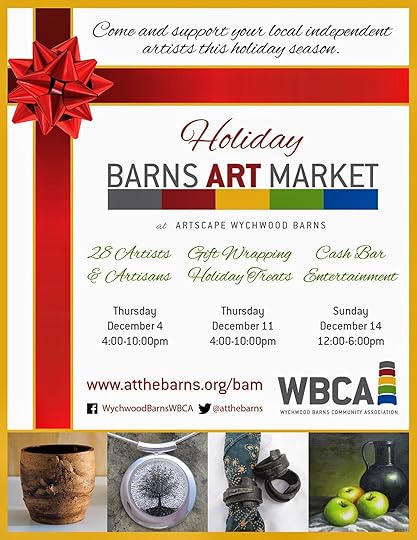
This date is important, because it marks the end of the draw submission for the original painting from "Animals In My Hair". I have requested you choose the final painting, and here are the finalists:
1. "Fox and Fan"

2. "Pandas"

3. "Ferrets"

Which of these do you like the best? Let me know in the Comments below; 1, 2, or 3. If I do not hear from you by the time I'm ready to pick the winner, I will make the choice myself.
I should be picking the winner early next week. I would like to do it over Google Hangouts, if I can figure it out, then I'll post the video here.
Wishing you all best of luck!
Mili

This date is important, because it marks the end of the draw submission for the original painting from "Animals In My Hair". I have requested you choose the final painting, and here are the finalists:
1. "Fox and Fan"

2. "Pandas"

3. "Ferrets"

Which of these do you like the best? Let me know in the Comments below; 1, 2, or 3. If I do not hear from you by the time I'm ready to pick the winner, I will make the choice myself.
I should be picking the winner early next week. I would like to do it over Google Hangouts, if I can figure it out, then I'll post the video here.
Wishing you all best of luck!
Mili
Published on December 11, 2014 15:01
December 6, 2014
"ANIMALS IN MY HAIR" KINDLE BOOK LAUNCH PARTY!
TODAY IS THE DAY!

CLICK HERE TO GET YOUR FREE KINDLE BOOK ON AMAZON!(December 6, 2014, Pacific Time)
Welcome to the Kindle Book Launch Party!!!
I will be available from 8 am to 8 pm (EST) to answer any questions you may have. Just post your questions in the comments below.
If you would like to win a physical prize...
Today, I will be asking you a few questions of my own. The first person to reply with the right answer WINS a Mili Fay Art Print of their choice (excluding "Horsing Around Limited Edition Print Series"). If you are a winner, feel free to explore the galleries and archive galleries on my Official Website and choose an image of your choice. Or you can visit my online store and chose from the prints available for sale.
In addition, all the art print winners will be entered into a draw to win a hardcover copy of "Animals In My Hair"!
Free shipping is included. :-D
(I will post a link to a YouTube video on Sunday, December 7th, 2014 of me choosing the winner.)
HINT: You may wish to download the book and watch the videos below to prepare for the questions. ;-)
Thank you so much for sharing this special day with me. If you have a minutes, after you have read the book and have explored the free AIMH Membership included in every copy, I would love to hear what you think of my work. It would mean a world to me if you could also post a short honest review on Amazon and/or Goodreads.
If you wish to stay in touch, feel free to join the Mili Fay Art Fan Club.
NOW, LET'S HAVE SOME FUN!
:-) Mili
Animals In My Hair Presentation: Part 01 Mili Fay takes you through the special features that make "Animals In My Hair" different from most picture books on the market today.
http://youtu.be/9IRqeEVDE5c
Animals In My Hair Presentation: Part 02 Mili Fay shows you the Kindle Edition of "Animals In My Hair".
http://youtu.be/AYoXhavyiMA
Animals In My Hair Presentation: Part 03 Mili Fay shows you how to access and use the AIMH Membership.
http://youtu.be/Gm47XKb64rc
STORE LINKS:
If you cannot use US or CA store to download you free copy, below are all the available store links from Amazon.
US http://www.amazon.com/dp/B00P1WRBJKCAhttp://www.amazon.ca/gp/product/B00P1WRBJKUKhttp://www.amazon.co.uk/gp/product/B00P1WRBJKAUhttp://www.amazon.com.au/gp/product/B00P1WRBJKINhttp://www.amazon.in/gp/product/B00P1WRBJKJPhttp://www.amazon.co.jp/gp/product/B00P1WRBJKFRhttp://www.amazon.fr/gp/product/B00P1WRBJKDEhttp://www.amazon.de/gp/product/B00P1WRBJKEShttp://www.amazon.es/gp/product/B00P1WRBJKIThttp://www.amazon.it/gp/product/B00P1WRBJKNLhttp://www.amazon.nl/gp/product/B00P1WRBJKBRhttps://www.amazon.com.br/dp/B00P1WRBJKMXhttps://www.amazon.com.mx/dp/B00P1WRBJK
-----------------------------------------

Mili Fay, a Toronto-based artist, classical animator, illustrator, writer, and singer, is an award winning graduate of Sheridan College and Art Instruction Schools. In November of 2011 she created Mili Fay Art determined to support the world one artwork at a time.
Her latest published work is Animals In My Hair ; a story about a boy who goes for his first haircut only to find endangered animals falling out of his hair. Presented at INSPIRE! Toronto International Book Fair (November 14, 2014) out of 700+ submissions, Animals In My Hair, is the world’s first ever Artwork Book; a new type of picture book that seamlessly combines the best features of fine art, picture books, activity books, and educational books.
In accordance with Mili Fay Art’s vision, 30% of all profits from Animals In My Hair book and merchandise will be donated to wildlife conservation.
Join Mili Fay Art Fan Club to stay in touch with Mili Fay and to be the first to find out of her upcoming books and artworks.
Mili Fay Art: “Together we support the world one artwork at a time.”

CLICK HERE TO GET YOUR FREE KINDLE BOOK ON AMAZON!(December 6, 2014, Pacific Time)
Welcome to the Kindle Book Launch Party!!!
I will be available from 8 am to 8 pm (EST) to answer any questions you may have. Just post your questions in the comments below.
If you would like to win a physical prize...
Today, I will be asking you a few questions of my own. The first person to reply with the right answer WINS a Mili Fay Art Print of their choice (excluding "Horsing Around Limited Edition Print Series"). If you are a winner, feel free to explore the galleries and archive galleries on my Official Website and choose an image of your choice. Or you can visit my online store and chose from the prints available for sale.
In addition, all the art print winners will be entered into a draw to win a hardcover copy of "Animals In My Hair"!
Free shipping is included. :-D
(I will post a link to a YouTube video on Sunday, December 7th, 2014 of me choosing the winner.)
HINT: You may wish to download the book and watch the videos below to prepare for the questions. ;-)
Thank you so much for sharing this special day with me. If you have a minutes, after you have read the book and have explored the free AIMH Membership included in every copy, I would love to hear what you think of my work. It would mean a world to me if you could also post a short honest review on Amazon and/or Goodreads.
If you wish to stay in touch, feel free to join the Mili Fay Art Fan Club.
NOW, LET'S HAVE SOME FUN!
:-) Mili
Animals In My Hair Presentation: Part 01 Mili Fay takes you through the special features that make "Animals In My Hair" different from most picture books on the market today.
http://youtu.be/9IRqeEVDE5c
Animals In My Hair Presentation: Part 02 Mili Fay shows you the Kindle Edition of "Animals In My Hair".
http://youtu.be/AYoXhavyiMA
Animals In My Hair Presentation: Part 03 Mili Fay shows you how to access and use the AIMH Membership.
http://youtu.be/Gm47XKb64rc
STORE LINKS:
If you cannot use US or CA store to download you free copy, below are all the available store links from Amazon.
US http://www.amazon.com/dp/B00P1WRBJKCAhttp://www.amazon.ca/gp/product/B00P1WRBJKUKhttp://www.amazon.co.uk/gp/product/B00P1WRBJKAUhttp://www.amazon.com.au/gp/product/B00P1WRBJKINhttp://www.amazon.in/gp/product/B00P1WRBJKJPhttp://www.amazon.co.jp/gp/product/B00P1WRBJKFRhttp://www.amazon.fr/gp/product/B00P1WRBJKDEhttp://www.amazon.de/gp/product/B00P1WRBJKEShttp://www.amazon.es/gp/product/B00P1WRBJKIThttp://www.amazon.it/gp/product/B00P1WRBJKNLhttp://www.amazon.nl/gp/product/B00P1WRBJKBRhttps://www.amazon.com.br/dp/B00P1WRBJKMXhttps://www.amazon.com.mx/dp/B00P1WRBJK
-----------------------------------------

Mili Fay, a Toronto-based artist, classical animator, illustrator, writer, and singer, is an award winning graduate of Sheridan College and Art Instruction Schools. In November of 2011 she created Mili Fay Art determined to support the world one artwork at a time.
Her latest published work is Animals In My Hair ; a story about a boy who goes for his first haircut only to find endangered animals falling out of his hair. Presented at INSPIRE! Toronto International Book Fair (November 14, 2014) out of 700+ submissions, Animals In My Hair, is the world’s first ever Artwork Book; a new type of picture book that seamlessly combines the best features of fine art, picture books, activity books, and educational books.
In accordance with Mili Fay Art’s vision, 30% of all profits from Animals In My Hair book and merchandise will be donated to wildlife conservation.
Join Mili Fay Art Fan Club to stay in touch with Mili Fay and to be the first to find out of her upcoming books and artworks.
Mili Fay Art: “Together we support the world one artwork at a time.”
Published on December 06, 2014 00:00
December 5, 2014
Mili Fay Presents: Animals In My Hair
 Click Here
to get your free copy of the bookon
December 6th, 2014
, Pacific Time.
Click Here
to get your free copy of the bookon
December 6th, 2014
, Pacific Time.Dear Reader,
In 2008 when I heard my mother tell my father that he should get a haircut, because his hair was like a forest (a very common Serbian expression), I began wondering what would it be like if our hair really was a forest. Surely, there would be animals living in the hair. But why? I thought about it and eventually decided that it would be because those animals had nowhere else to live.
That is how the story of a little boy who goes for his first haircut only to discover that endangered animals where hiding within was born. It took five years, and all of my skills as an animator, illustrator, writer, singer, and tutor to create a multilayered story that would appeal to all generations.
I am at an age when most of my friends are building families. I have always thought books a perfect present for any age, but I found to my despair that so many of the books in stores were dedicated to one topic, a specific age group, and were so simple that one could absorb a book in a single sitting. I wanted to gift my friends a book that they could open year after year, and always discover something new and remember how much I care for them.
With this in mind, I wrote the story in free verse so that the rhythm of the language would appeal to babies; I included 80% more illustrations than a typical picture book, so that even if the reader cannot read or speak English he/she would be able to follow the story; I developed a visual style that combined animated characters with realism, so that the reader could learn through observation; I have invented visual puzzles to be discovered throughout the book…
Layers upon layers.
The hardcover book has been published a little over a year, and thus far, from the response I have received at the fairs and art shows, I believe I have managed to create a rather unique book. However, today I will let you be the judge.
Recently, I have created a Kindle Edition of the book. The original hardcover has been reformatted, and now you can see all of the illustrations in true RGB glory, which is closer to the original watercolour scans than the CMYK reproduction of the printed book.
Today only, “Animals In My Hair” will be free to download from Amazon.
Please take a look at the three short educational videos below, download the book for free, join the Kindle Launch Party, join the free AIMH Membership, explore what the book has to offer, and let me know what you think.
Wishing you only the best!
Mili Fay
Animals In My Hair Presentation: Part 01 (Run Time: 8:28 min)
 http://youtu.be/9IRqeEVDE5c
http://youtu.be/9IRqeEVDE5cAnimals In My Hair Presentation: Part 02 (Run Time: 3:49 min)
 http://youtu.be/AYoXhavyiMA
http://youtu.be/AYoXhavyiMAAnimals In My Hair Presentation: Part 03 (Run Time: 5:03 min)
 http://youtu.be/Gm47XKb64rc
http://youtu.be/Gm47XKb64rc-----------------------------------------

Mili Fay, a Toronto-based artist, classical animator, illustrator, writer, and singer, is an award winning graduate of Sheridan College and Art Instruction Schools. In November of 2011 she created Mili Fay Art determined to support the world one artwork at a time.
Her latest published work is Animals In My Hair ; a story about a boy who goes for his first haircut only to find endangered animals falling out of his hair. Presented at INSPIRE! Toronto International Book Fair (November 14, 2014) out of 700+ submissions, Animals In My Hair, is the world’s first ever Artwork Book; a new type of picture book that seamlessly combines the best features of fine art, picture books, activity books, and educational books.
In accordance with Mili Fay Art’s vision, 30% of all profits from Animals In My Hair book and merchandise will be donated to wildlife conservation.
Join Mili Fay Art Fan Club to stay in touch with Mili Fay and to be the first to find out of her upcoming books and artworks.
Mili Fay Art: “Together we support the world one artwork at a time.”
Published on December 05, 2014 21:00



